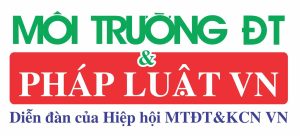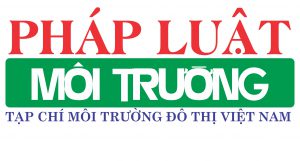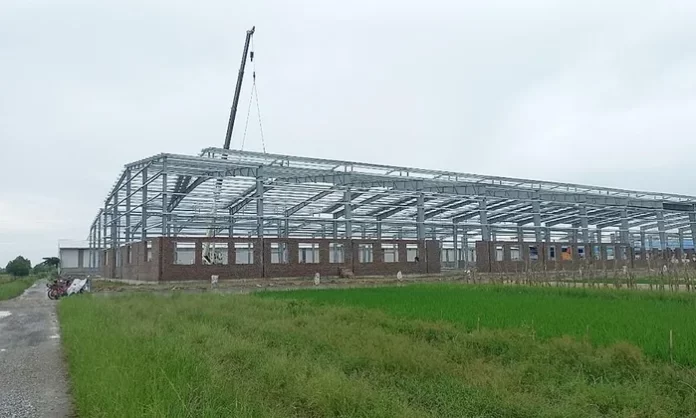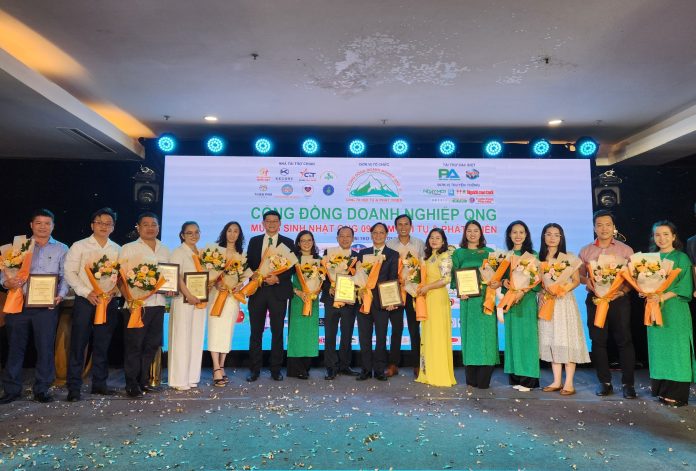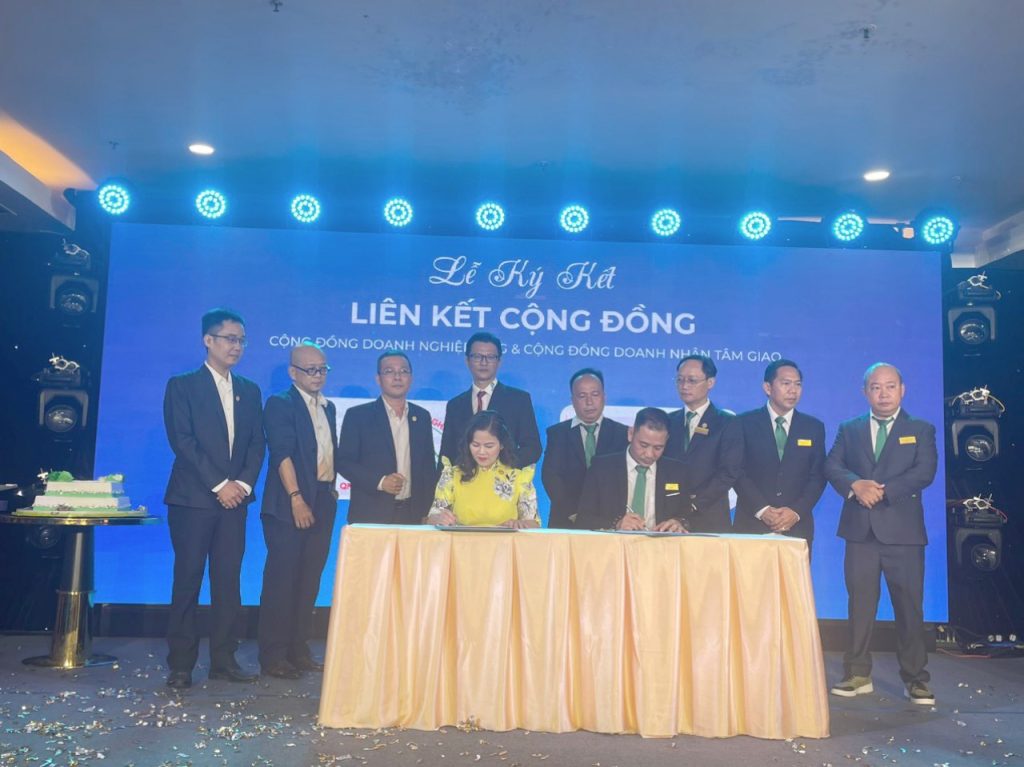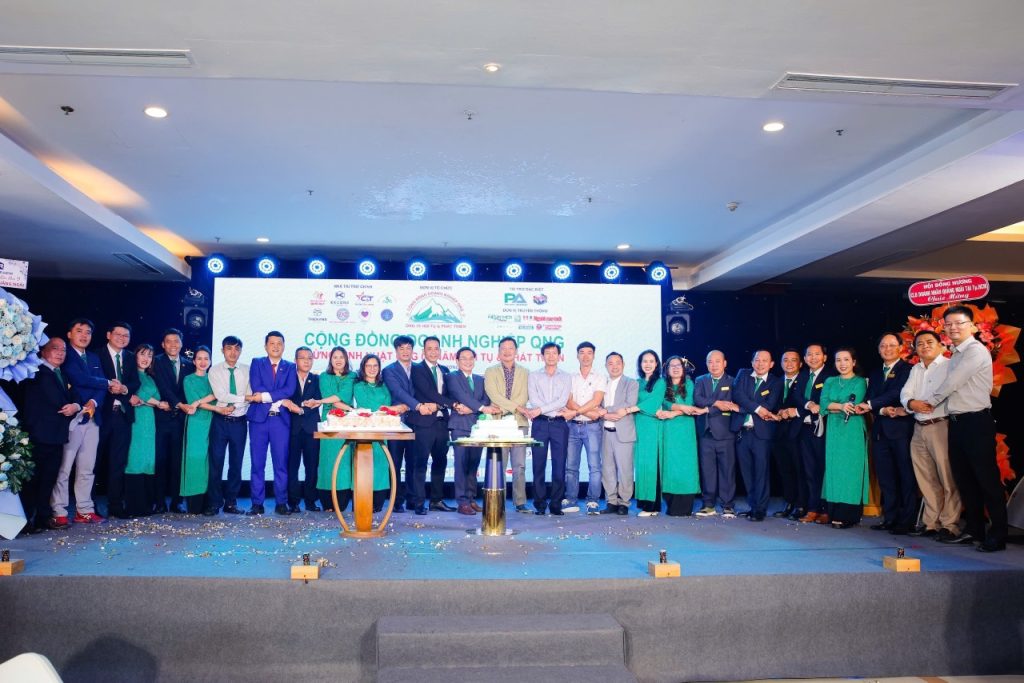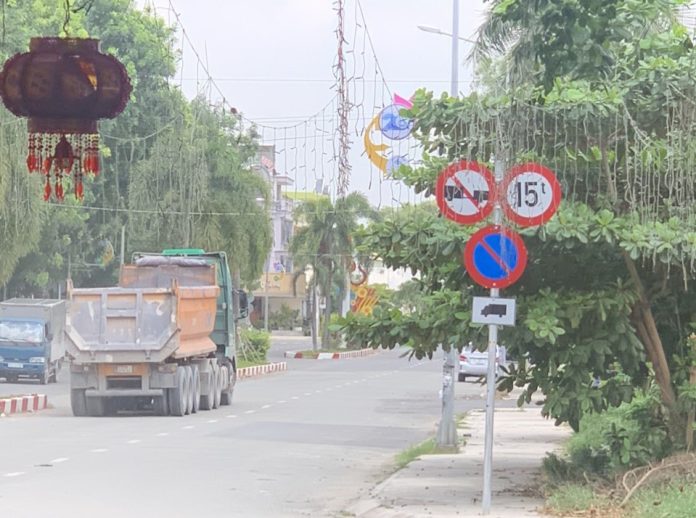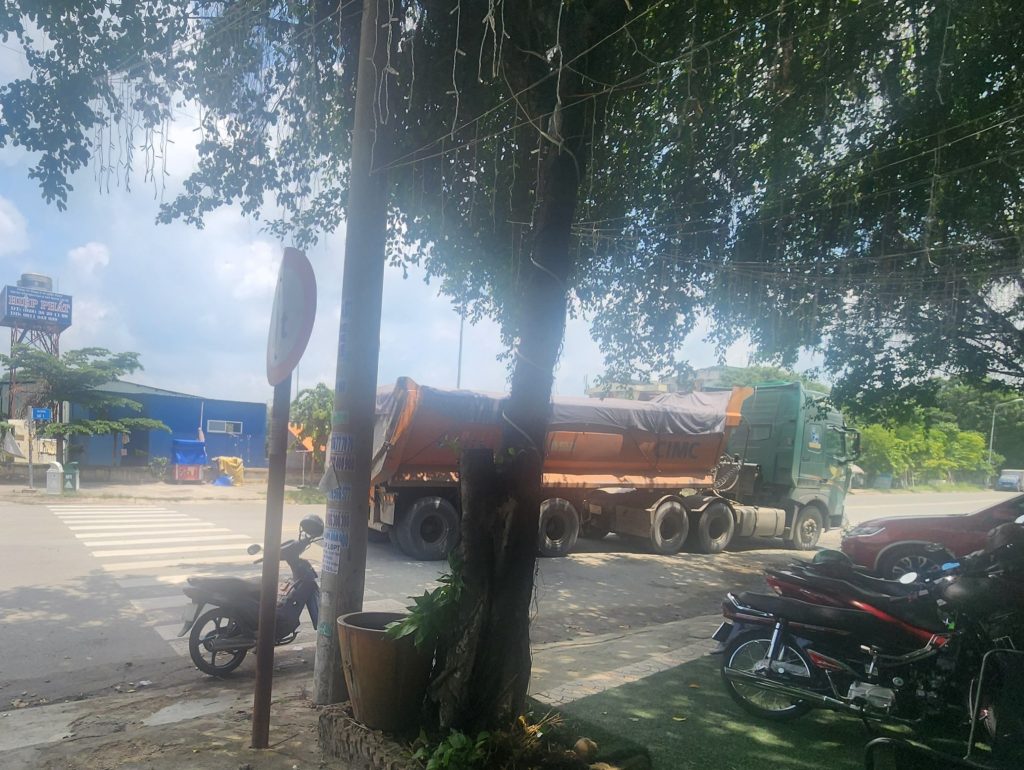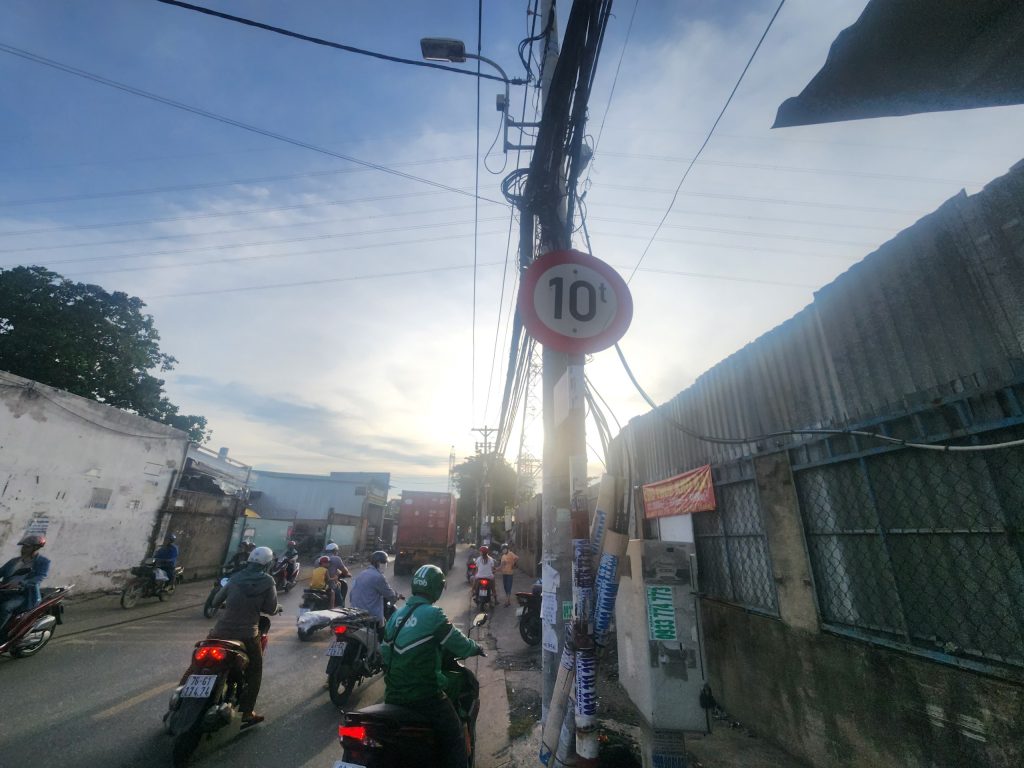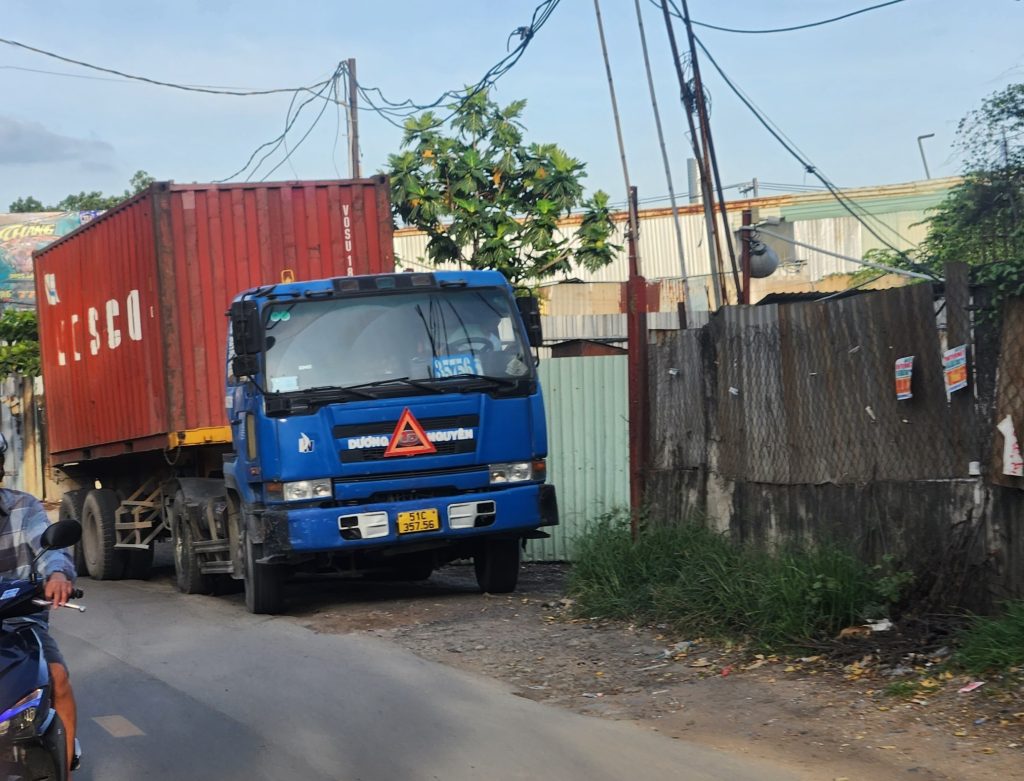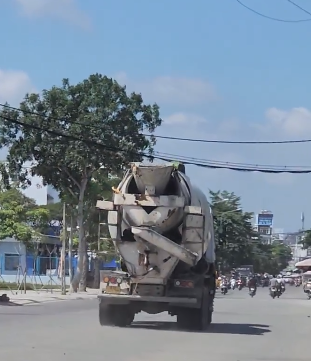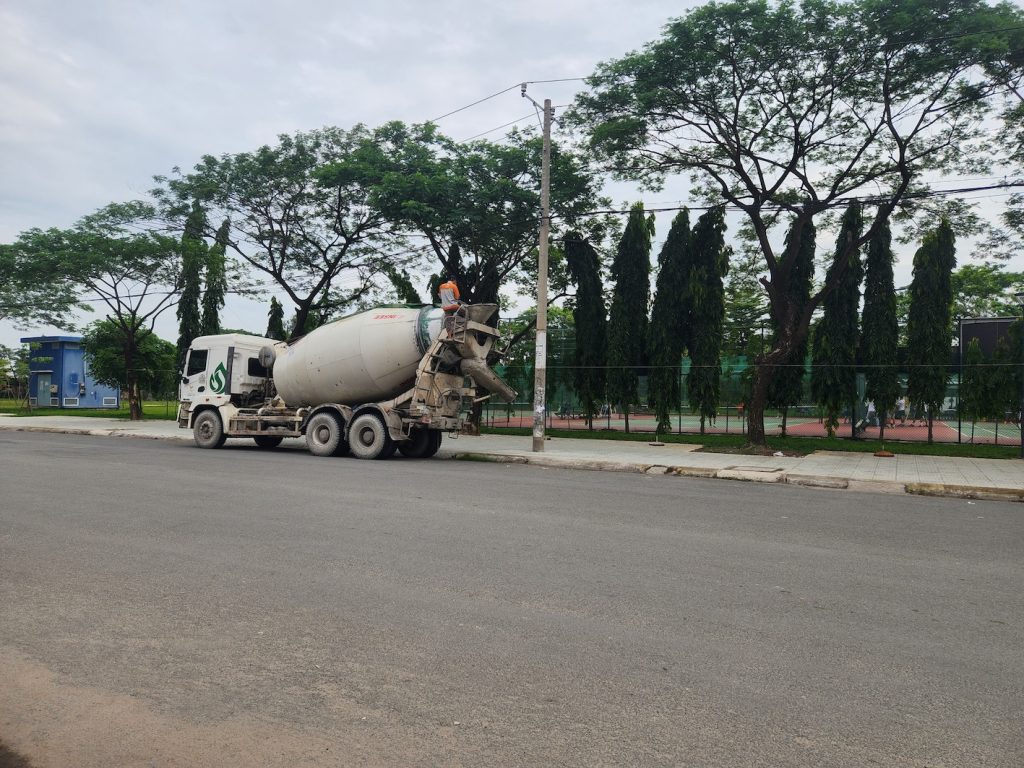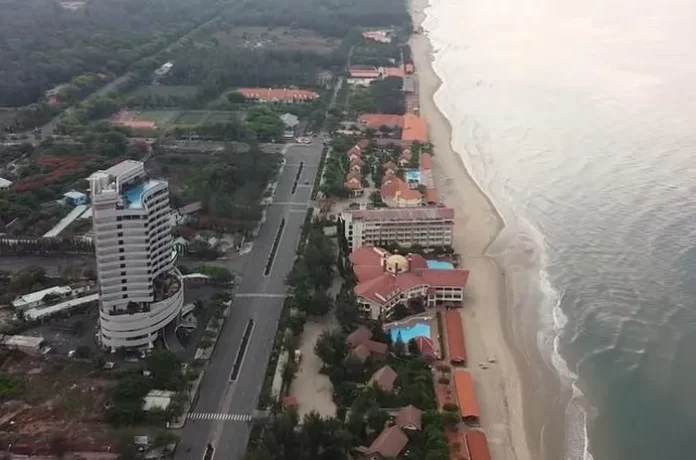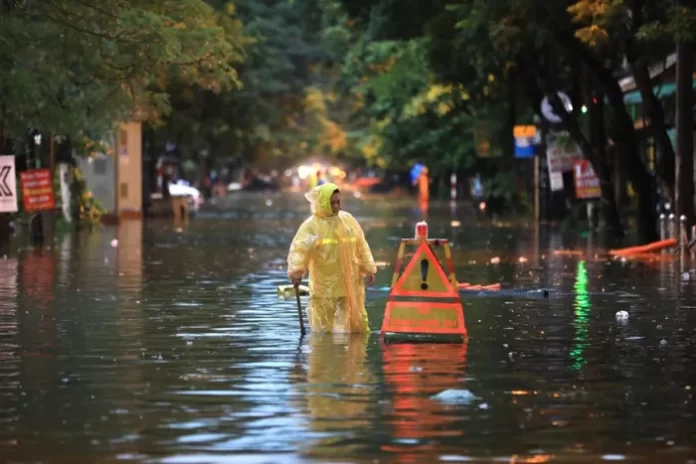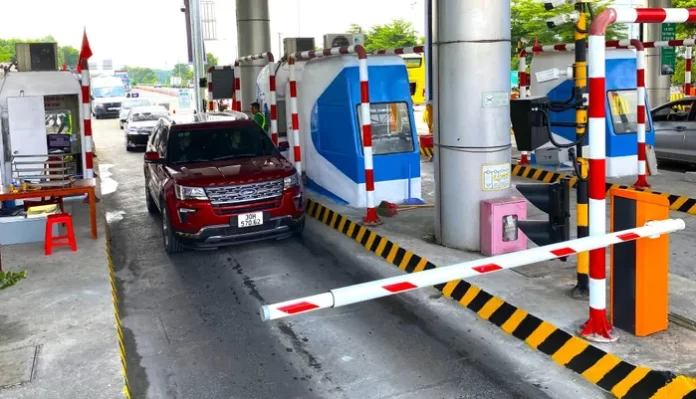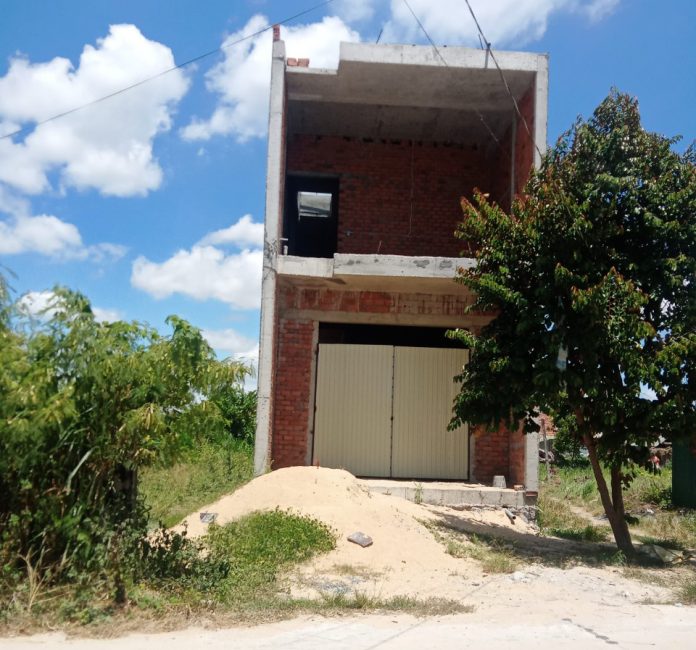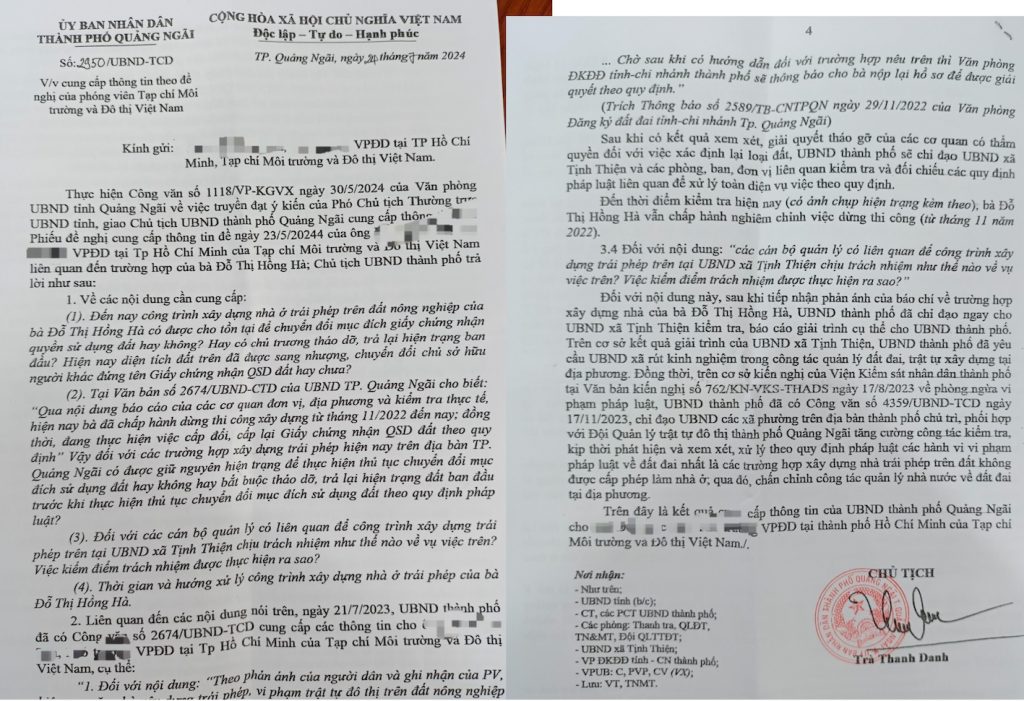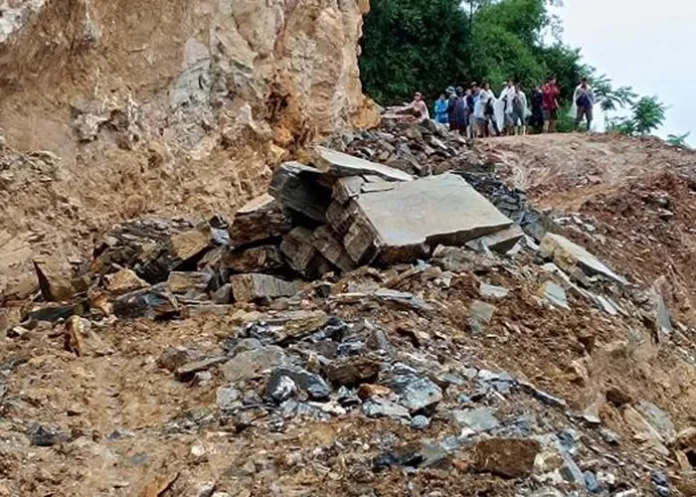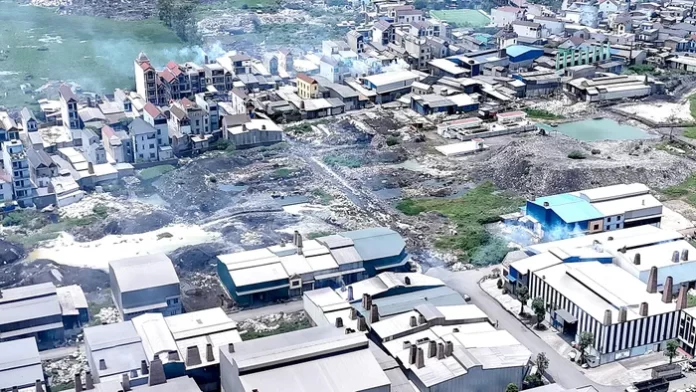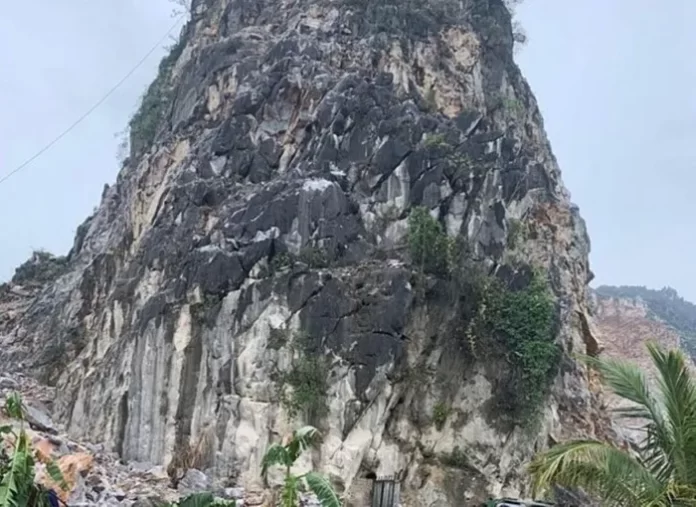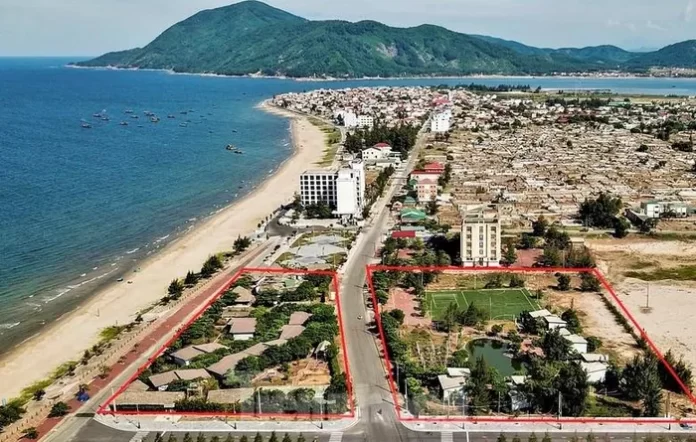Ban biên tập Chuyên trang Quản lý Môi trường, Tạp chí Môi trường và Đô thị Việt Nam trân trọng giới thiệu tới quý độc giả Công bố quốc tế lĩnh vực môi trường số 29-2024.
Về quản lý môi trường
– Phân tích chlorhexidine, kháng sinh và thành phần cộng đồng vi khuẩn trong môi trường nước từ Brazil, Cameroon và Madagascar trong đại dịch COVID-19.
– Kiểm tra tác động không đối xứng của bất bình đẳng thu nhập, phát triển tài chính và phát triển con người lên dấu chân sinh thái ở Türkiye: Cách tiếp cận NARDL.
– Phân tích chuỗi thời gian (2003-15) của các thông số lý hóa được chọn trong Ấn Độ Dương: Dự đoán tác động tích lũy lên hiện tượng tẩy trắng san hô bằng học máy.
– Liệu tác động tích lũy của các nguồn tài nguyên công nghệ có thể thúc đẩy đổi mới công nghệ xanh hợp tác trong các khu vực dựa trên tài nguyên không?
– Phân tích thống kê và tác động môi trường của các sự kiện tăng trưởng hạt bụi hiện có ở một siêu đô thị ven biển Bắc Trung Quốc: Nghiên cứu 725 ngày từ năm 2010 – 2018.
– Liệu sự tiếp xúc với biến đổi khí hậu có ảnh hưởng đến tài chính doanh nghiệp và hiệu suất năng lượng không? Khám phá vai trò điều tiết của kinh nghiệm xanh của các CEO.
– Giảm ô nhiễm không khí không nhất thiết giảm gánh nặng tử vong liên quan ở người lớn: Sự biến đổi ở 177 quốc gia với các mức độ kinh tế khác nhau.
– Chuyển đổi năng lượng bền vững trong các thành phố: Mô hình dự đoán thống kê sâu cho quản lý các nguồn năng lượng tái tạo để phát triển đô thị carbon thấp.
– Đánh giá tác động sức khỏe của ô nhiễm nước mặt ở Trung Quốc.
Về môi trường đô thị
– Phân bố, huy động, đánh giá rủi ro và nhận diện nguồn gốc của kim loại nặng và chất dinh dưỡng trong trầm tích bề mặt của ba con sông đô thị-nông thôn sau khi xử lý ô nhiễm nước dài hạn.
– Khám phá cảnh quan sinh thái của kháng β-lactam của vi khuẩn ở vùng thủ đô Delhi, Ấn Độ: Một mối lo ngại sức khỏe mới nổi.
– Sự xuất hiện tích hợp của các chất gây ô nhiễm mới nổi, bao gồm vi nhựa, trong các lưu vực đô thị và nông nghiệp ở bang São Paulo, Brazil.
– Phân tích kết hợp không gian-thời gian của PM2.5 và Ozone ở California với phương pháp INLA.
– Phân bổ nguồn gốc của các hạt aerosol mịn của các loài hòa tan trong nước và cacbon đo được ở vùng bán đô thị (Kharagpur) và siêu đô thị (Kolkata) qua đồng bằng Indo-Gangetic phía đông: Đặc điểm hóa học, sự phong phú tương đối và đóng góp của con người.
– Cải thiện quá trình tiêu hóa kỵ khí nhiệt độ cao của chất thải rắn đô thị với sự phân tách không gian từ các vật liệu dẫn điện trong một thể tích phản ứng đơn.
– Đồng carbon hóa thủy nhiệt bùn đô thị và chất thải nông nghiệp để giảm ức chế sự phát triển của thực vật bởi các sản phẩm pha nước: Phân tích ở cấp độ phân tử của chất hữu cơ.
– Quản lý hệ thống năng lượng tích hợp đô thị bền bỉ: Trạng thái hiện tại và định hướng tương lai.
– Các mô hình phân loại đường phố theo đặc điểm đô thị để ước lượng tiếng ồn giao thông đường bộ.
Về môi trường khu công nghiệp
– Quản lý dữ liệu Môi trường, Xã hội và Quản trị (ESG) an toàn cho các dự án xây dựng bằng công nghệ Blockchain.
– Nghiên cứu thiết lập kho dữ liệu về chất gây ô nhiễm không khí và phát thải carbon, cùng với tiềm năng giảm phát thải đồng bộ của ngành công nghiệp luyện cốc Trung – Quốc từ năm 2012 đến 2022.
– Tiềm năng khử carbon đồng bộ từ ngành công nghiệp xây dựng và các ngành thượng nguồn ở quy mô thành phố: Nghiên cứu điển hình tại Hàng Châu, Trung Quốc.
– Phân tích khả năng khắc phục ô nhiễm của sinh khối Aspergillus flavus trong nước thải của ngành công nghiệp nhuộm: Nghiên cứu in-vitro.
– Phương pháp tập hợp neutrosophic ngôn ngữ Pythagorean để đánh giá công nghệ kiểm soát ô nhiễm nước trong ngành công nghiệp bột giấy và giấy.
– Sự thay đổi của dòng chảy vật liệu và tác động môi trường cùng với các kịch bản nâng cấp tương lai của pin NCM tại Trung Quốc.
– Luyện kim sinh khối: Con đường bền vững và xanh hướng tới ngành luyện kim trung tính carbon.
– Nền kinh tế tuần hoàn chất thải thủy tinh – Tiến tới thu hồi các tấm kính có giá trị cao bằng cách sử dụng công nghệ công nghiệp 4.0 và 5.0.
– Các mô hình kinh doanh và thiết kế sản phẩm kéo dài tuổi thọ của quần áo bảo hộ trong xây dựng: Thành công, thất bại và tác động môi trường.
CHUYÊN TRANG QUẢN LÝ MÔI TRƯỜNG
Tạp chí Môi trường và Đô thị Việt Nam
Xin trân trọng giới thiệu!
ENVIRONMENTAL MANAGEMENT / QUẢN LÝ MÔI TRƯỜNG
1. Analysis of chlorhexidine, antibiotics and bacterial community composition in water environments from Brazil, Cameroon and Madagascar during the COVID-19 pandemic
Science of The Total Environment, Volume 932, 1 July 2024, 173016
Abstract
The widespread of chlorhexidine and antibiotics in the water bodies, which grew during the global COVID-19 pandemic, can increase the dispersion of antibiotic resistance. We assessed the occurrence of these pharmaceutical compounds as well as SARS-CoV-2 and analysed the bacterial community structure of hospital and urban wastewaters from Brazil, Cameroon, and Madagascar. Water and wastewater samples (n = 59) were collected between January–June 2022. Chlorhexidine, azithromycin, levofloxacin, ceftriaxone, gentamicin and meropenem were screened by Ultra-High-Performance Liquid Chromatography coupled with mass spectrometer. SARS-CoV-2 was detected based on the nucleocapsid gene (in Cameroon and Madagascar), and envelope and spike protein-encoding genes (in Brazil). The total community-DNA was extracted and used for bacterial community analysis based on the 16S rRNA gene. To unravel likely interaction between pharmaceutical compounds and/or SARS-CoV-2 with the water bacterial community, multivariate statistics were performed. Chlorhexidine was found in hospital wastewater effluent from Brazil with a maximum concentration value of 89.28 μg/L. Additionally, antibiotic residues such as azithromycin and levofloxacin were also present at concentrations between 0.32–7.37 μg/L and 0.11–118.91 μg/L, respectively.
In Cameroon, azithromycin was the most found antibiotic present at concentrations from 1.14 to 1.21 μg/L. In Madagascar instead, ceftriaxone (0.68–11.53 μg/L) and levofloxacin (0.15–0.30 μg/L) were commonly found. The bacterial phyla statistically significant different (P < 0,05) among participating countries were Proteobacteria, Patescibacteria and Dependentiae which were mainly abundant in waters sampled in Africa and, other phyla such as Firmicutes, Campylobacterota and Fusobacteriota were more abundant in Brazil. The phylum Caldisericota was only found in raw hospital wastewater samples from Madagascar.
The canonical correspondence analysis results suggest significant correlation of azithromycin, meropenem and levofloxacin with bacteria families such as Enterococcaceae, Flavobacteriaceae, Deinococcaceae, Thermacetogeniaceae and Desulfomonilaceae, Spirochaetaceae, Methanosaetaceae, Synergistaceae, respectively. Water samples were also positive for SARS-CoV-2 with the lowest number of hospitalized COVID-19 patients in Madagascar (n = 7) and Brazil (n = 30). Our work provides new data about the bacterial community profile and the presence of pharmaceutical compounds in the hospital effluents from Brazil, Cameroon, and Madagascar, whose limited information is available. These compounds can exacerbate the spreading of antibiotic resistance and therefore pose a risk to public health.
2. Sustainable energy transition in cities: A deep statistical prediction model for renewable energy sources management for low-carbon urban development
Sustainable Cities and Society, Volume 107, 15 July 2024, 105434
Abstract
This study proposes a novel approach to sustainable energy transition in urban environments, focusing on the prediction and management of renewable energy outputs for low-carbon urban development. We introduce a new intelligent prediction model based on Gated Recurrent Unit (GRU) Networks to forecast the output power of both tidal and biomass units. The GRU model, known for its capability in capturing sequential dependencies, is employed to enhance the accuracy of renewable energy predictions in the context of urban sustainability. To address the interpretability challenges inherent in complex deep learning models, we leverage LIME (Local Interpretable Model-agnostic Explanations). By integrating LIME into our GRU-based prediction model, we enhance transparency and understandability.
This approach facilitates the identification of key factors influencing predictions, providing stakeholders and decision-makers with valuable insights for effective sustainable energy management. The proposed hybrid model is applied to the digital model of real tidal and biomass sites in China, allowing for a statistical examination of renewable integration and energy management strategies. The results offer a comprehensive understanding of the dynamics between renewable energy sources and urban development, paving the way for informed decision-making in the pursuit of low-carbon and resilient cities. This research contributes to the broader discourse on sustainable urban development by offering a robust statistical framework for renewable energy integration and management in urban environments.
3. Green-gray imbalance: Rapid urbanization reduces the probability of green space exposure in early 21st century China
Science of The Total Environment, Volume 933, 10 July 2024, 173168
Abstract
Green space exposure provides greater beneficial effects on residents compared to unnatural spaces, commonly referred to as “gray spaces”. However, during rapid urbanization, gray spaces expand more quickly than green spaces, often encroaching upon and overtaking these natural environments. This unchecked growth leads to detrimental impacts on the human habitat and overall environmental quality. Consequently, it is essential to meticulously assess the spatial and temporal patterns of residents’ exposure levels, as well as to thoroughly investigate the underlying driving mechanisms behind these changes. This study used population-weighted exposure level measurements to assess gray and green space exposure in Chinese cities in the early 21st Century (2000–2019).
Additionally, the Gray-Green space Exposure Ratio (GER) was calculated, and the spatiotemporal driving mechanism of GER by each factor was analyzed by geostatistical modeling. The results show that gray space exposure is generally increasing in China, especially in eastern parts of China. The probability of exposure to gray spaces exceeds that of green spaces in some high urbanization rate cities. This trend will continue, albeit at a slower rate. Urban sprawl, built-up area density, and increased electricity consumption were the main drivers of rising GER, whereas greenspace integrity contributed to lower GER; the driving mechanisms for GER changes were spatiotemporal heterogeneous. This study provides a reliable reference for restoring the green space exposure to promote the living environment constructing and residents’ access to nature.
4. Ecological boundaries and their regional exceedance in China
Journal of Cleaner Production, Volume 461, 5 July 2024, 142669
Abstract
Planetary boundaries have received considerable attention since they were first proposed, but applying various downscaling methods to the regional scale has certain limitations due to regional heterogeneity. The concept of ecological boundaries (EB) extends and complements planetary boundaries at a regional scale. However, previous studies have not considered the EB of multiple regions and the impact of interregional ecosystem service value (ESV) flows on EB. In this study, we optimized the EB accounting method and quantified the EB of 30 provinces in China from 2002 to 2017, then assessed the ecosystem unsustainability, and determined the impact of demand for goods and services on the consumption of local natural resources by each province in China using an ESV-extended multiregional input-output model.
We found that EB increased in all provinces of China. The ecological unsustainability index of all 30 provinces was larger than 1, indicating a serious environmental unsustainability, but the magnitude of the index tends to decrease. Furthermore, the regions that have the greatest impact on exceeding EB in each province were concentrated in Guangdong and Henan. Guangdong had the highest total net imports in 2012 and 2015 (665.08 and 641.70 billion yuan, respectively), while Henan had the highest total net imports in 2017 (611.58 billion yuan). For the role of net exports, the rankings of the provinces differed in terms of the direct ESV and the boundary-exceeding ESV indicators. Our results reveal EB across provinces in China, underscoring the importance of considering the flow of ESV between regions in assessing the impact of exceeding EB. This study can assist policymakers in better allocating ecological resources within EB, which is critical for alleviating ecological pressures.
5. Time series (2003–15) analysis of selected physicochemical parameters in Indian Ocean: Cumulative impacts prediction on coral bleaching using machine learning
Science of The Total Environment, Volume 933, 10 July 2024, 173002
Abstract
Coral bleaching is an important ecological threat worldwide, as the coral ecosystem supports a rich marine biodiversity to survive. Sea surface temperature was considered a major culprit; however, later it was observed that other water parameters like pH, tCO2, fCO2, salinity, dissolved oxygen, etc. also play a significant role in bleaching. In the present study, all these parameters of the Indian Ocean area for 15 years (2003–2017) were collected and analysed using machine learning language. The main aim is to see the cumulative impacts of various ocean parameters on coral bleaching. Introducing machine learning in environmental impact assessment studies is a new approach, and the prediction of coral bleaching using simulation of physico-chemical parameters interactions shows 94.4 % accuracy for the prediction of the future bleaching event. This study can be probably the first step in the application of the machine learning language for the prediction of coral bleaching in the field of marine science.
6. Can the cumulative effect of technological resources promote green technology collaborative innovation in resource-based regions?
Journal of Cleaner Production, Volume 461, 5 July 2024, 142589
Abstract
Resource-based regions are encountering increasingly severe challenges in their green transformation and development. Urgent action is required from innovation entities to achieve more sustainable green technology innovation through Green technology collaborative innovation (GTCI). To enhance the driving mechanism of GTCI, this study categorizes technological resources into tangible and intangible categories and examines their cumulative effects on GTCI from the perspective of innovation entities. Using a network evolution perspective, this research builds multi-stage GTCI networks by utilizing green joint invention authorized patent data from 2000 to 2020, and empirically examines them using exponential random graph models.
The study finds that the cumulative effect of intangible resources of technology can promote GTCI in resource-based areas, but it needs a certain period of quantitative change to trigger the qualitative change of the cumulative effect; the cumulative effect of technology tangible resources does not promote GTCI in resource-based regions and inhibits GTCI in some stages of development. This study contributes to the advancement of the resource-based view theory and broadens the research scope of the GTCI network. It also facilitates the establishment of a market-oriented green technology innovation system with enterprises as the primary focus, thereby promoting the optimized development of GTCI in resource-based regions.
7. Temporal evolution of speciated volatile organic compound (VOC) emissions from solvent use sources in the Pearl River Delta Region, China (2006–2019)
Science of The Total Environment, Volume 933, 10 July 2024, 172888
Abstract
Volatile organic compounds (VOCs) emitted from solvent use sources constitute an important part of ozone (O3) and secondary organic aerosols (SOA) in the Pearl River Delta (PRD) region, China. While stringent control measures targeting VOCs have been implemented in recent years, an assessment of historical trends is imperative to evaluate their effectiveness. In this study, trends of VOC emissions, compositions, and reactivity from solvent use sources in the PRD region from 2006 to 2019 were estimated using a developed methodology, which considered the improvement of manufacturing equipment and removal efficiency.
Results showed that total VOC emissions from solvent use sources displayed an overall increase from 277 kt in 2006 to 400 kt in 2019 despites some fluctuations, with metal products contributing more than 20 % each year. Aromatics and oxygenated VOCs (OVOCs) accounted for over 70 % of total VOC emissions, increasing by 21 kt and 52 kt respectively. OFP and SOAFP increased by 40 % and 23 % respectively from 2006 to 2019. Specific aromatic species, including m/p-xylene, toluene, 1,2,3,5-tetramethylbenzene, o-xylene and ethylbenzene were identified as key species in both VOC emission amount and reactivity. This study aims to facilitate the understanding of VOC emission evolution from solvent use sources in the region and provide insights into the impact of enacted measures, aiding in the future development of more targeted and efficient strategies in the PRD region.
8. Can retail investor activism inhibit corporate greenwashing behavior: Evidence from investor interactive platforms in China
Journal of Cleaner Production, Volume 461, 5 July 2024, 142617
Abstract
Different from developed markets, China capital market is dominated by retail investors. In the digital age, retail investors are increasingly making their voice heard through online channels, which is a new form of shareholder activism in China. This paper examines the association between retail investor activism (RIA) and corporate greenwashing behavior (CGB) using the data of question raised by investors on official investor interactive platforms (IIPs) in China. We discover that the RIA on IIPs is negatively associated with CGB.
The mechanism analysis shows that the RIA helps to curb CGB through promoting information transparency and improving internal corporate governance level. We also find that the association between RIA and CGB is strengthened in regions with weaker green finance and environmental regulation, and in industries with weaker product market competition. This indicates that the RIA, a type of private governance, can serve as a substitute to the governance effect of the government and the product market. Further studies show that RIA on unofficial channels such as stock forums or search engines can promote CGB, contrary to the conclusion about IIPs. Our research suggests that strengthening the rights of retail investors through official channels helps to reduce CGB and demonstrates the importance of official channels in the governance role of RIA in emerging markets.
9. Statistical analysis and environmental impact of pre-existing particle growth events in a Northern Chinese coastal megacity: A 725-day study in 2010 – 2018
Science of The Total Environment, Volume 933, 10 July 2024, 173227
Abstract
Pre-existing particles usually constitute the major fraction of atmospheric particles, except during some episodes in the presence of strong emissions and/or secondary generation of fresh particles. Previous case studies have investigated the growth of pre-existing particles and their potential environmental and climate impacts. However, there is limited knowledge about the statistical characteristics of these growth events and related effects. In this study, we examine pre-existing particle growth events using a large dataset (725 days from 2010 to 2018) collected at a coastal megacity in northern China. The occurrence frequency of pre-existing particle growth events was 12.4 % (90 out of 725 days). When these events were related to measured criteria air pollutants, no significant differences were found in PM2.5, SO2, NO2 and NO2 + O3 concentrations between periods with and without pre-existing particle growth events.
These 90-day events can be further classified into two categories, i.e., Category 1, with 68 % of events representing the growth of pre-existing particles alone, and Category 2, with 32 % of events representing the simultaneous growth of pre-existing and newly formed particles. In Category 2, the growth rates of pre-existing particles and newly formed particles were close in 21 % of the cases, while pre-existing particles exhibited significantly larger growth rates in 69 % of the cases. Conversely, in 10 % of the cases, the growth rates of newly formed particles were larger. The different growth rate mechanisms were discussed in terms of the volatility of atmospheric condensation vapors. In addition, we present case studies on the impact of pre-existing particle growth on cloud condensation nuclei simultaneously measured, specifically considering the chemistry of condensation vapors and pre-existing particles.
10. Does climate change exposure impact on corporate finance and energy performance? Unraveling the moderating role of CEOs’ green experience
Journal of Cleaner Production, Volume 461, 5 July 2024, 142653
Abstract
This study examines how firm-level exposure to climate change shapes sustainable financial and energy performance. We utilize a robust two-way fixed-effects approach to examine 2905 Chinese listed enterprises spanning 2010 to 2022. Our primary objective is to unravel the direct effects of climate change exposure (CCE) on corporate financial performance (CFP) and corporate energy performance (CEP), and to explore how CEOs’ green experience moderates these effects.
The findings delineate significant adverse effects on CFP and CEP stemming from CCE. Notably, augmenting CEOs’ green experience can help to mitigate these effects. We also emphasize the pivotal roles of green technology innovation (GTI) and the augmentation of environmental, social, and governance (ESG) performance as primary conduits through which CCE influences CFP and CEP. Our study illuminates nuanced variations in these influences that are based on climate risk type, geographical regions, firm scale, and industry. These insights offer fresh theoretical perspectives and robust evidence that are crucial for tackling climate-related challenges, especially in the context of emerging economies such as China. They also provide important implications for government actions, suggesting ways to refine environmental policy at the firm level.
11. Reducing air pollution does not necessarily reduce related adults’ mortality burden: Variations in 177 countries with different economic levels
Science of The Total Environment, Volume 933, 10 July 2024, 173037
Abstract
Prolonged exposure to PM2.5 is associated with increased mortality. However, reducing air pollution concentrations does not necessarily reduce the related burden of deaths. Here, we aim to estimate the variations in PM2.5-related mortality due to contributions from key factors – PM2.5 concentration, population exposure, and healthcare levels – for 177 countries from 2000 to 2018 at the 1-km grid scale according to the Global Mortality Exposure Model (GEMM) model. We find that global reductions in PM2.5-related deaths mainly come from high and upper-middle income countries, where lowered air pollutant concentration and better healthcare can offset mortality burdens caused by increasing exposed populations. Changes in population exposure to PM2.5 contribute the most (54 %) to change in global related deaths over the examined period, followed by changes in healthcare (−42 %) and pollution concentrations (4 %). The impacts vary across countries and regions within them due to other drivers, which are significantly influenced by development status. Policies aiming at reducing PM2.5 associated health risks need to account for country-specific balances of these key socioeconomic drivers.
12. Testing the asymmetric impacts of income inequality, financial development and human development on ecological footprint in Türkiye: A NARDL approach
Journal of Cleaner Production, Volume 461, 5 July 2024, 142652
Abstract
This study aims to explore the asymmetric effects of income inequality, financial development, and human development on the ecological footprint in Türkiye between 1990 and 2021, as well as the symmetric impacts of energy consumption, economic growth, trade openness, and urbanization. The Nonlinear Autoregressive Distributed Lag method is employed to examine the short- and long-term relationships among the variables. This study distinguishes itself from previous research by examining the asymmetric effects of income inequality, human development, and financial development on the environment in Türkiye, where significant economic and social transformations have occurred in the past few decades and have had severe impacts on the environment.
The study’s key findings demonstrate that shocks in income inequality, financial development, and human development have significant impacts on the ecological footprint. Our findings indicate the importance of using disaggregated data in the analyses. The results related to control variables indicate that energy consumption and economic growth exacerbate ecological pressure, while urbanization mitigates it. These findings have significant implications for policymakers, who can achieve socioeconomic and environmental gains by addressing crucial issues such as green job creation, green technologies, green financing, and environmental education.
13. Health impact assessment of the surface water pollution in China
Science of The Total Environment, Volume 933, 10 July 2024, 173040
Abstract
China suffers from severe surface water pollution. Health impact assessment could provide a novel and quantifiable metric for the health burden attributed to surface water pollution. This study establishes a health impact assessment method for surface water pollution based on classic frameworks, integrating the multi-pollutant city water quality index (CWQI), informative epidemiological findings, and benchmark public health information. A relative risk level assignment approach is proposed based on the CWQI, innovatively addressing the challenge in surface water-human exposure risk assessment. A case study assesses the surface water pollution-related health impact in 336 Chinese cities.
The results show (1) between 2015 and 2022, total health impact decreased from 3980.42 thousand disability-adjusted life years (DALYs) (95 % Confidence Interval: 3242.67–4339.29) to 3260.10 thousand DALYs (95 % CI: 2475.88–3641.35), measured by total cancer. (2) The annual average health impacts of oesophageal, stomach, colorectal, gallbladder, and pancreatic cancers added up to 2621.20 thousand DALYs (95 % CI: 2095.58–3091.10), revealing the significant health impact of surface water pollution on digestive cancer. (3) In 2022, health impacts in the Beijing-Tianjin-Hebei and surroundings, the Yangtze River Delta, and the middle reaches of the Yangtze River added up to 1893.06 thousand DALYs (95 % CI: 1471.82–2097.88), showing a regional aggregating trend. (4) Surface water pollution control has been the primary driving factor to health impact improvement, contributing −3.49 % to the health impact change from 2015 to 2022. It is the first city-level health impact map for China’s surface water pollution. The methods and findings will support the water management policymaking in China and other countries suffering from water pollution.
14. Dynamic spatial–temporal model for carbon emission forecasting
Journal of Cleaner Production, Volume 463, 15 July 2024, 142581
Abstract
Addressing the urgent need for accurate carbon emissions forecasting to support global emissions reduction goals, this paper introduces a novel approach for carbon emissions prediction that dynamically considers the spatial–temporal correlation of carbon emissions across forecasting targets. Traditional statistical and machine learning models have limitations, such as oversimplification and inefficiency in capturing evolving dynamics among multiple forecasting targets, alongside a focus on longer forecasting horizons like monthly or yearly.
To tackle these, we propose an innovative Dynamic Spatial–Temporal Graph Convolutional Recurrent Network (DSTGCRN), a blend of graph convolutional and recurrent neural network structures customized for up-to-date multi-regional spatial–temporal predictions at a daily level. Comprehensive empirical analyses on datasets from China, the US, and the EU confirm DSTGCRN’s superior performance and robustness across diverse geographical contexts. It outperforms the second-best among 10 baseline models, achieving 40.6%, 24.6%, and 38.5% improvements in MAE, RMSE, and MAPE, respectively, across various horizons. The incorporation of environmental data, including temperature and Air Quality Index, as supplementary predictors in the DSTGCRN model, has demonstrated its efficacy in the context of the China dataset. The DSTGCRN model’s improved accuracy and daily multi-regional forecasting deepen emission dynamics understanding, supporting the development of informed and region-specific environmental policies that can respond promptly to changes.
15. Green-gray imbalance: Rapid urbanization reduces the probability of green space exposure in early 21st century China
Science of The Total Environment,Volume 933, 10 July 2024, 173168
Abstract
Green space exposure provides greater beneficial effects on residents compared to unnatural spaces, commonly referred to as “gray spaces”. However, during rapid urbanization, gray spaces expand more quickly than green spaces, often encroaching upon and overtaking these natural environments. This unchecked growth leads to detrimental impacts on the human habitat and overall environmental quality. Consequently, it is essential to meticulously assess the spatial and temporal patterns of residents’ exposure levels, as well as to thoroughly investigate the underlying driving mechanisms behind these changes.
This study used population-weighted exposure level measurements to assess gray and green space exposure in Chinese cities in the early 21st Century (2000–2019). Additionally, the Gray-Green space Exposure Ratio (GER) was calculated, and the spatiotemporal driving mechanism of GER by each factor was analyzed by geostatistical modeling. The results show that gray space exposure is generally increasing in China, especially in eastern parts of China. The probability of exposure to gray spaces exceeds that of green spaces in some high urbanization rate cities. This trend will continue, albeit at a slower rate. Urban sprawl, built-up area density, and increased electricity consumption were the main drivers of rising GER, whereas greenspace integrity contributed to lower GER; the driving mechanisms for GER changes were spatiotemporal heterogeneous. This study provides a reliable reference for restoring the green space exposure to promote the living environment constructing and residents’ access to nature.
16. Deployment of carbon removal technologies could reduce the rapid and potentially disruptive pace of decarbonization in South Africa’s climate ambitions
Journal of Cleaner Production, Volume 464, 20 July 2024, 142753
Abstract
As a developing country, South Africa faces the risk of having to undertake disruptive actions to meet its internationally pledged emission reduction targets. It has become necessary to find alternative measures for South Africa to meet its climate targets without such a disruptive and aggressive transformation of its energy sector. To truly reach net-zero CO2 emissions, South Africa must ensure that residual emissions from its recalcitrant sectors are equally compensated by carbon dioxide removal (CDR). Given the potential for CDR technologies to delay the need for rapid emissions cuts, we leverage this characteristic to explore their role in helping South Africa achieve its climate targets on time, but through a less disruptive and overly aggressive pace of energy system decarbonization.
Using an integrated assessment model, we show that while reaching its emission reduction targets, the presence of novel CDR (nCDR) approaches could significantly reduce South Africa’s mitigation costs to $155-240/tCO2 instead of $190–590/tCO2 by 2050 in the absence of nCDR. Furthermore, the availability of nCDR may allow for a more gradual transition towards renewable and nuclear power generation compared to scenarios without nCDR. Importantly, we reveal that nCDR could help avoid asset stranding of up to 4–6 GW and $15–25 billion in associated costs between 2016 and 2050. However, this comes at the cost of higher residual greenhouse gas emissions due to the continued reliance on fossil fuels under nCDR availability. Overall, South Africa’s priority must remain on decarbonization, especially in sectors where fuel switching and energy efficiency are feasible. Nonetheless, the complementary role of nCDR must not be underestimated, and South Africa should begin investing in these emerging technologies to support its ambitious climate goals.
URBAN ENVIRONMENT/ MÔI TRƯỜNG ĐÔ THỊ
1. Distribution, mobilization, risk assessment and source identification of heavy metals and nutrients in surface sediments of three urban-rural rivers after long-term water pollution treatment
Science of The Total Environment, Volume 932, 1 July 2024, 172894
Abstract
Sediments are critical pollution carriers in urban-rural rivers, which can threaten the water quality of the river and downstream lakes for a long time. However, it is still not clear whether conventional water pollution treatments could abate sediment pollution or not. In this study, heavy metals (HMs) and nutrient salts in the surface sediments and overlying water were investigated after decades’ water pollution treatment in three urban-rural rivers. HM speciation was determined by the sequential extraction; diffusion fluxes were estimated using Fick’s first law; HM ecological risk and nutrient pollution were evaluated; and pollution sources were identified by statistical analysis and GIS.
The results showed that the HMs and nutrients were extremely serious in the urban regions. The accumulation level of Pb, Cu and Cd in the sediments of the three rivers were all much higher than the soil background value, and the labile fractions accounted for high proportions (57 % for Pb, 55 % for Cu and 43 % for Cd), which could be easily eluate from the sediments and caused hazards to the aquatic environment. The sediment diffusion fluxes of HMs and ammonia nitrogen were mostly positive, which indicated these sites currently released these pollutants from sediment to overlying water. Cd, Pb, Cu and Cr may mainly originate from industrial discharge and domestic sewage, while Cr was also greatly affected by crustal weathering; nutrient pollution may originate from agricultural activities and domestic sewage. Our study demonstrated that after decades’ conventional water treatment in these rivers, the sediment pollution was still in a serious level with high ecological risk, and Cd was the dominant pollutant. At present, the external point source pollution has been effectively controlled, thus, the in-depth understanding of the sediment pollution characteristics after long-term water treatment could provide a scientific basis for the accurate elimination of river pollution.
2. Unveiling the ecological landscape of bacterial β-lactam resistance in Delhi-national capital region, India: An emerging health concern
Journal of Environmental Management, Volume 363, July 2024, 121288
Abstract
Inappropriate antibiotic use not only amplifies the threat of antimicrobial resistance (AMR), moreover exacerbates the spread of resistant bacterial strains and genes in the environment, underscoring the critical need for effective research and interventions. Our aim is to assess the prevalence and resistance characteristics of β-lactam resistant bacteria (BLRB) and β-lactamase resistant bacterial genes (BLRBGs) under various environmental conditions within Delhi NCR, India. Using a culture-dependent method, we isolated 130 BLRB from 75 different environmental samples, including lakes, ponds, the Yamuna River, agricultural soil, aquatic weeds, drains, dumping yards, STPs, and gaushalas.
Tests for antibiotic susceptibility were conducted in addition to phenotypic and genotypic identification of BLs and integron genes. The water and sediment samples recorded an average bacterial abundance of 3.6 × 106 CFU/mL and an average ampicillin-resistant bacterial count of 2.2 × 106 CFU/mL, which can be considered a potent reservoir of BLRB and BLRBGs. The majority of the BLRB discovered are opportunistic pathogens from the Bacillus, Aeromonas, Pseudomonas, Enterobacter, Escherichia, and Klebsiella genera, with Multiple Antibiotic Resistance (MAR) index ≥0.2 against a wide variety of β-lactams and β-lactamase (BLs) inhibitor combinations. The antibiotic resistance pattern was similar in the case of bacteria isolated from STPs. Meanwhile, bacteria isolated from other sources were diverse in their antibiotic resistance profile. Interestingly, we discovered that 10 isolates of various origins produce both Extended Spectrum BLs and Metallo BLs, as well as found harboring blaTEM, blaCTX, blaOXA, blaSHV, int-1, and int-3 genes. Enterobacter cloacae (S50/A), a common nosocomial pathogen isolated from Yamuna River sediment samples at Nizamuddin point, possesses three BLRBGs (blaTEM, blaCTX, and blaOXA) and a MAR index of 1.0, which is a major cause for concern. Therefore, identifying the source, origin and dissemination of BLRB and BLRGs in the environment is of the utmost importance for designing effective mitigation approaches to reduce a load of antimicrobial resistance factors in the environmental settings.
3. Integrated occurrence of contaminants of emerging concern, including microplastics, in urban and agricultural watersheds in the State of São Paulo, Brazil
Science of The Total Environment, Volume 932, 1 July 2024, 173025
Abstract
Contaminants of emerging concern (CECs), including microplastics, have been the focus of many studies due to their environmental impact, affecting biota and human health. The diverse land uses and occupation of watersheds are important parameters driving the occurrence of these contaminants. CECs such as pesticides, drugs, hormones, and industrial-origin substances were analyzed in urban/industrial (Atibaia) and agricultural (Preto/Turvo) watersheds located in São Paulo state, Brazil. A total of 24 CECs were investigated, and, as a result, only 5 (caffeine, carbendazim, atrazine, ametrine and 2-hydroxytrazine) were responsible for 81.73 % of the statistical difference between watersheds contamination profile.
The Atibaia watershed presented considerable concentrations of caffeine (ranging from 75 to 2025 ng L−1), while carbendazim (44 to 1144 ng L−1) and atrazine (3 to 266 ng L−1) presented highest levels in Preto/Turvo watershed. In all sampling points, the cumulative potential aquatic life risk assessed by the NORMAN database indicates some level of environmental concern associated to pesticides and caffeine (risk quotient >1). Microplastics had been analyzed in both watersheds, being the white/transparent fragments in size between 100 and 250 μm the most detected in this study. The estimated abundance in the Atibaia watershed ranged from 349 to 2898 items m−3 presenting some influence of pluviosity, while in Rio Preto/Turvo ranged from 169 to 6370 items m−3, being more abundant in the dam area without a clear influence of pluviosity. In both basins, polyethylene and polypropylene were the most detected polymers, probably due to the intense use of single-use plastics in urban areas. Possibly, due to the distinct physic-chemical properties of microplastics and organic CECs, no correlations were observed between their occurrence, which makes us conclude that they have different transport mechanism, behavior, and fate in the environment.
4. Spatiotemporal joint analysis of PM2.5 and Ozone in California with INLA approach
Journal of Environmental Management, Volume 363, July 2024, 121294
Abstract
The substantial threat of concurrent air pollutants to public health is increasingly severe under climate change. To identify the common drivers and extent of spatiotemporal similarity of PM2.5 and ozone (O3), this paper proposed a log Gaussian–Gumbel Bayesian hierarchical model allowing for sharing a stochastic partial differential equation and autoregressive model of order one (SPDE-AR(1)) spatiotemporal interaction structure. The proposed model, implemented by the approach of integrated nested Laplace approximation (INLA), outperforms in terms of estimation accuracy and prediction capacity for its increased parsimony and reduced uncertainty, especially for the shared O3 sub-model. Besides the consistently significant influence of temperature (positive), extreme drought (positive), fire burnt area (positive), gross domestic product (GDP) per capita (positive), and wind speed (negative) on both PM2.5 and O3, surface pressure and precipitation demonstrate positive associations with PM2.5 and O3, respectively.
While population density relates to neither. In addition, our results demonstrate similar spatiotemporal interactions between PM2.5 and O3, indicating that the spatial and temporal variations of these pollutants show relatively considerable consistency in California. Finally, with the aid of the excursion function, we see that the areas around the intersection of San Luis Obispo and Santa Barbara counties are likely to exceed the unhealthy O3 level for USG simultaneously with other areas throughout the year. Our findings provide new insights for regional and seasonal strategies in the co-control of PM2.5 and O3. Our methodology is expected to be utilized when interest lies in multiple interrelated processes in the fields of environment and epidemiology.
5. Source apportionment of fine aerosol particles of water-soluble and carbonaceous species measured in semi-urban (Kharagpur) and megacity (Kolkata) atmospheres over the eastern Indo-Gangetic plain: Chemical characterisation, relative abundance and anthropogenic contributions
Science of The Total Environment, Volume 932, 1 July 2024, 170795
Abstract
We conducted the source apportionment of fine aerosol particles (aerodynamic diameter ≤1.6�m) collected with the indigenously designed-fabricated submicron aerosol sampler (SAS) in the eastern Indo-Gangetic plain (IGP) semi-urban (Kharagpur, KGP) and megacity (Kolkata, KOL) atmospheres, examining the chemical characteristics at KGP (January 2015–February 2016), and accentuating their abundance and the sources of anthropogenic pollution relative to KOL. The fine water-soluble inorganic ions (WSII) at KGP predominantly constituted Ca2+ (52 %) and equivalent amounts (12 % each) of Cl−, Mg2+ and secondary inorganic aerosols (sum of SO42−, NO3− and NH4+). The annual mean of SO42− at KGP was twice (thrice) larger than NO3− (NH4+); this of organic carbon (OC) was thrice elemental carbon (EC), with secondary OC being 37 % of the total OC.
The concordance in peaks of OC with K+ concentrations was identified during the seasonal open biomass burning at KGP (November and May). While the annual mean of OC (EC) concentration at KGP was slightly lower than (nearly equivalent to) KOL; K+, NO3−, NH4+ and F− concentrations at KOL were twice larger than KGP. Source quantification using Positive Matrix Factorization (PMF) revealed the regional dust with crustal elements marked as clean (polluted) at KGP (KOL) constituted the largest fractional contribution among the six identified factors at both KGP and KOL. The combustion-derived anthropogenic pollution comprising about 60 % (50 %) of fine particles at KOL (KGP) was predominantly from the transportation sector (in vehicular emissions and regional dust), coal combustion (industries) and open biomass burning at KOL; it was from brick kilns, residential biofuel combustion, and open biomass burning at KGP. The source-wide distribution of measured aerosol species showed their emergence from largely different sources at KGP and KOL; thereby suggesting a prioritised strategy for sustainable emissions mitigation considering the prominent sources of combustion-derived anthropogenic pollution and aerosol species for megacity and semi-urban atmospheres.
6. Enhanced thermophilic high-solids anaerobic digestion of organic fraction of municipal solid waste with spatial separation from conductive materials in a single reactor volume
Journal of Environmental Management, Volume 363, July 2024, 121434
Abstract
Despite benefits such as lower water and working volume requirements, thermophilic high solids anaerobic digestion (THSAD) often fails due to the rapid build-up of volatile fatty acids (VFAs) and the associated drop in pH. Use of conductive materials (CM) can promote THSAD through stimulation of direct interspecies electron transfer (DIET), while the need for their constant dosing due to poor separation from effluent impairs economic feasibility. This study used an approach of spatially separating magnetite and granular activated carbon (GAC) from the organic fraction of municipal solid waste (OFMSW) in a single reactor for THSAD. GAC and magnetite addition could both mitigate the severe inhibition of methanogenesis after VFAs build-up to ∼28–30 g/L, while negligible methane production was observed in the control group.
The highest methane yield (286 mL CH4/g volatile solids (VS)) was achieved in magnetite-added reactors, while the highest maximum CH4 production rates (26.38 mL CH4/g VS/d) and lowest lag-phase (2.83 days) were obtained in GAC-added reactors. The enrichment of GAC and magnetite biofilms with various syntrophic and potentially electroactive microbial groups (Ruminiclostridium 1, Clostridia MBA03, Defluviitoga, Lentimicrobiaceae) in different relative abundances indicates the existence of specific preferences of these groups for the nature of CM. According to predicted basic metabolic functions, CM can enhance cellular processes and signals, lipid transport and metabolism, and methane metabolism, resulting in improved methane production. Rearrangement of metabolic pathways, formation of pili-like structures, enrichment of biofilms with electroactive groups and a significant improvement in THSAD performance was attributed to the enhancement of the DIET pathway. Promising results obtained in this work due to the spatial separation of the bulk OFMSW and CM can be useful for modeling larger-scale THSAD systems with better recovery of CM and cost-effectiveness.
7. Co-hydrothermal carbonization of municipal sludge and agricultural waste to reduce plant growth inhibition by aqueous phase products: Molecular level analysis of organic matter
Science of The Total Environment, Volume 932, 1 July 2024, 173073
Abstract
The organic matter molecular mechanism by which combined hydrothermal carbonization (co-HTC) of municipal sludge (MS) and agricultural wastes (rice husk, spent mushroom substrate, and wheat straw) reduces the inhibitory effects of aqueous phase (AP) products on pak choi (Brassica campestris L.) growth compared to HTC of MS alone is not clear. Fourier-transform ion cyclotron resonance mass spectrometry was used to characterize the differences in organic matter at the molecular level between AP from MS HTC alone (AP-MS) and AP from co-HTC of MS and agricultural waste (co-Aps). The results showed that N-bearing molecules of AP-MS and co-Aps account for 70.6 % and 54.2 %–64.1 % of all molecules, respectively. Lignins were present in the highest proportion (56.3 %–78.5 %) in all APs, followed by proteins and lipids. The dry weight of co-APs hydroponically grown pak choi was 31.6 %–47.6 % higher than that of the AP-MS. Molecules that were poorly saturated and with low aromaticity were preferentially consumed during hydroponic treatment.
Molecules present before and after hydroponics were defined as resistant molecules; molecules present before hydroponics but absent after hydroponics were defined as removed molecules; and molecules absent before hydroponics but present after hydroponics were defined as produced molecules. Large lignin molecules were broken down into more unsaturated molecules, but lignins were the most commonly resistant, removed, and produced molecules. Correlation analysis revealed that N- or S-bearing molecules were phytotoxic in the AP. Tannins positively influenced the growth of pak choi. These results provide new insights into potential implementation strategies for liquid fertilizers produced from AP arising from HTC of MS and agricultural wastes.
8. Management of resilient urban integrated energy system: State-of-the-art and future directions
Journal of Environmental Management, Volume 363, July 2024, 121318
Abstract
The urban integrated energy system (UIES) is the fundamental infrastructure supporting the operation of resilient cities. The resilience of UIES plays a critical role in effectively responding to extreme events. We provide a comprehensive review on the management of resilient UIES. Firstly, we examine the existing studies on the resilience of UIES through quantitative and qualitative methodologies. Secondly, it points out that the coupling characteristics of UIES have a dual impact on resilience.
The definition of UIES resilience can be understood from three perspectives, namely partial resilience versus total resilience, physical resilience versus digital resilience, and current resilience versus future resilience. Thirdly, this review summarizes the strategies for improving the resilience of UIES across three distinct stages, namely before, during, and after extreme events. The resilience of UIES can be enhanced by effective measures to prediction, adaptation, and assessment. Finally, the challenges faced by management of resilient UIES are presented and discussed, in terms of mitigating compound risks, modeling complex systems, addressing data collection and quality issue, and collaborating within multi stakeholders.
9. Streets classification models by urban features for road traffic noise estimation
Science of The Total Environment, Volume 932, 1 July 2024, 173005
Abstract
Road traffic is the primary source of environmental noise pollution in cities. This problem is also spreading due to inadequate urban expansion planning. Hence, integrating road traffic noise analysis into urban planning is necessary for reducing city noise in an effective, adaptable, and sustainable way. This study aims to develop a methodology that applies to any city for the stratification of urban roads by their functionality through only their urban features. It is intended to be a tool to cluster similar streets and, consequently, traffic noise to enable urban and transportation planners to support the reduction of people’s noise exposure. Three multivariate ordered logistic regression statistical models (Model 1, 2, and 3) are presented that significantly stratify urban roads into five, four, and three categories, respectively. The developed models exhibit a McFadden pseudo-R2 between 0.5 and 0.6 (equivalent to R2 >0.8).
The choice between Model 1 or 2 depends on the scale of the city. Model 1 is recommended for developed cities with an extensive road network, while Model 2 is most suitable in intermediate and growing cities. On the other hand, Model 3 could be applied at any city scale but focused on local management of transit routes and for designing acoustic sensor installations, urban soundwalks, and identification of quiet areas. Urban features related to road width and length, presence of transport infrastructure, and public transport routes are associated with increased traffic noise in all three models. These models prove useful for future action plans aimed at reducing noise through strategic urban planning.
10. Impact of urban space on PM2.5 distribution: A multiscale and seasonal study in the Yangtze River Delta urban agglomeration
Journal of Environmental Management, Volume 363, July 2024, 121287
Abstract
Despite concerted efforts in emission control, air pollution control remains challenging. Urban planning has emerged as a crucial strategy for mitigating PM2.5 pollution. What remains unclear is the impact of urban form and their interactions with seasonal changes. In this study, base on the air quality monitoring stations in the Yangtze River Delta urban agglomeration, the relationship between urban spatial indicators (building morphology and land use) and PM2.5 concentrations was investigated using full subset regression and variance partitioning analysis, and seasonal differences were further analysed.
Our findings reveal that PM2.5 pollution exhibits different sensitivities to spatial scales, with higher sensitivity to the local microclimate formed by the three-dimensional structure of buildings at the local scale, while land use exerts greater influence at larger scales. Specifically, land use indicators contributed sustantially more to the PM2.5 prediction model as buffer zone expand (from an average of 2.41% at 100 m range to 47.30% at 5000 m range), whereas building morphology indicators display an inverse trend (from an average of 13.84% at 100 m range to 1.88% at 5000 m range). These results enderscore the importance of considering building morphology in local-scale urban planning, where the increasing building height can significantly enhance the disperion of PM2.5 pollution. Conversely, large-scale urban planning should prioritize the mixed use of green spaces and construction lands to mitigate PM2.5 pollution. Moreover, the significant seasonal differences in the ralationship between urban spatical indicatiors and PM2.5 pollution were observed. Particularly moteworthy is the heightened association between forest, water indicators and PM2.5 concentrations in summer, indicating the urban forests may facilitate the formation of volatile compunds, exacerbating the PM2.5 pollution. Our study provides a theoretical basis for addressing scale-related challenges in urban spatial planning, thereby forstering the sustainable development of cities.
11. Identification of environmental and methodological factors driving variability of Pepper Mild Mottle Virus (PMMoV) across three wastewater treatment plants in the City of Toronto
Science of The Total Environment, Volume 932, 1 July 2024, 172917
Abstract
PMMoV has been widely used to normalize the concentration of severe acute respiratory syndrome coronavirus 2 (SARS-CoV-2) RNA, influenza, and respiratory syncytial virus (RSV) to account for variations in the fecal content of wastewater. PMMoV is also used as an internal RNA recovery control for wastewater-based epidemiology (WBE) tests. While potentially useful for the interpretation of WBE data, previous studies have suggested that PMMoV concentration can be affected by various physico-chemical characteristics of wastewater. There is also the possibility that laboratory methods, particularly the variability in centrifugation steps to remove supernatant from pellets can cause PMMoV variability.
The goal of this study is to improve our understanding of the main drivers of PMMoV variability by assessing the relationship between PMMoV concentration, the physico-chemical characteristics of wastewater, and the methodological approach for concentrating wastewater samples. We analyzed 24-hour composite wastewater samples collected from the influent stream of three wastewater treatment plants (WWTPs) located in the City of Toronto, Ontario, Canada. Samples were collected 3 to 5 times per week starting from the beginning of March 2021 to mid-July 2023. The influent flow rate was used to partition the data into wet and dry weather conditions. Physico-chemical characteristics (e.g., total suspended solids (TSS), biological oxygen demand (BOD), alkalinity, electrical conductivity (EC), and ammonia (NH3)) of the raw wastewater were measured, and PMMoV was quantified. Spatial and temporal variability of PMMoV was observed throughout the study period. PMMoV concentration was significantly higher during dry weather conditions. Multiple linear regression analysis demonstrates that the number and type of physico-chemical parameters that drive PMMoV variability are site-specific, but overall BOD and alkalinity were the most important predictors. Differences in PMMoV concentration for a single WWTP between two different laboratory methods, along with a weak correlation between pellet mass and TSS using one method may indicate that differences in sample concentration and subjective subsampling bias could alter viral recovery and introduce variability to the data.
12. Integrated framework to assess soil potentially toxic element contamination through 3D pollution analysis in a typical mining city
Chemosphere, Volume 359, July 2024, 142378
Abstract
Soil potentially toxic elements (PTEs) pollution of contaminated sites has become a global environmental issue. However, given that previous studies mostly focused on pollution assessment in surface soils, the current status and environmental risks of potentially toxic elements in deeper soils remain unclear. The present study aims to cognize distribution characteristics and spatial autocorrelation, pollution levels, and risk assessment in a stereoscopic environment for soil PTEs through 3D visualization techniques. Pollution levels were assessed in an integrated manner by combining the geoaccumulation index (Igeo), the integrated influence index of soil quality (IICQs), and potential ecological hazard index. Results showed that soil environment at the site was seriously threatened by PTEs, and Cu and Cd were ubiquitous and the predominant pollutants in the study area.
The stratigraphic models and pollution plume simulation revealed that pollutants show a decreasing trend with the deepening of the soil layer. The ranking of contamination soil volume is as follows: Cu > Cd > Zn > As > Pb > Cr > Ni. According to the IICQs evaluation, this region was subject to multiple PTE contamination, with more than 60% of the area becoming seriously and highly polluted. In addition, the ecological hazard model revealed the existence of substantial ecological hazards in the soils of the site. The integrated potential ecological risk index (RI) indicated that 45.7%, 10.13%, and 4.15% of the stereoscopic areas were in considerable, high, and very high risks, respectively. The findings could be used as a theoretical reference for applying multiple methods to integrate evaluation through 3D visualization analysis in the assessment and remediation of PTE-contaminated soils.
13. Intelligent technologies powering clean incineration of municipal solid waste: A system review
Science of The Total Environment, Volume 935, 20 July 2024, 173082
Abstract
Cleanliness has been paramount for municipal solid waste incineration (MSWI) systems. In recent years, the rapid advancement of intelligent technologies has fostered unprecedented opportunities for enhancing the cleanliness of MSWI systems. This paper offers a review and analysis of cutting-edge intelligent technologies in MSWI, which include process monitoring, intelligent algorithms, combustion control, flue gas treatment, and particulate control. The objective is to summarize current applications of these techniques and to forecast future directions. Regarding process monitoring, intelligent image analysis has facilitated real-time tracking of combustion conditions.
For intelligent algorithms, machine learning models have shown advantages in accurately forecasting key process parameters and pollutant concentrations. In terms of combustion control, intelligent systems have achieved consistent prediction and regulation of temperature, oxygen content, and other parameters. Intelligent monitoring and forecasting of carbon monoxide and dioxins for flue gas treatment have exhibited satisfactory performance. Concerning particulate control, multi-objective optimization facilitates the sustainable utilization of fly ash. Despite remarkable progress, challenges remain in improving process stability and monitoring instrumentation of intelligent MSWI technologies. By systematically summarizing current applications, this timely review offers valuable insights into the future upgrade of intelligent MSWI systems.
14. Viral respiratory infections and air pollution: A review focused on research in Poland
Chemosphere, Volume 359, July 2024, 142256
Abstract
The COVID-19 pandemic has reinforced an interest in the relationship between air pollution and respiratory viral infections, indicating that their burden can be increased under poor air quality. This paper reviews the pathways through which air pollutants can enhance susceptibility to such infections and aggravate their clinical course and outcome. It also summarizes the research exploring the links between various viral infections and exposure to solid and gaseous pollution in Poland, a region characterized by poor air quality, especially during a heating season. The majority of studies focused on concentrations of particulate matter (PM; 86.7%); the other pollutants, i.e., BaP, benzene, CO, NOx, O3, and SO2, were studied less often and sometimes only in the context of a particular infection type. Most research concerned COVID-19, showing that elevated levels of PM and NO2 correlated with higher morbidity and mortality, while increased PM2.5 and benzo[a]pyrene levels were related to worse clinical course and outcome in hospitalized, regardless of age and dominant SARS-CoV-2 variant. PM10 and PM2.5 levels were also associated with the incidence of influenza-like illness and, along with NO2 concentrations, with a higher rate of children’s hospitalizations due to lower respiratory tract RSV infections.
Higher levels of air pollutants also increased hospitalization due to bronchitis (PM, NOx, and O3) and emergency department admission due to viral croup (PM10, PM2.5, NOx, CO, and benzene). Although the conducted studies imply only correlations and have other limitations, as discussed in the present paper, it appears that improving air quality through reducing combustion processes in energy production in Poland should be perceived as a part of multilayered protection measures against respiratory viral infections, decreasing the healthcare costs of COVID-19, lower tract RSV infections, influenza, and other respiratory viral diseases prevalent between autumn and early spring, in addition to other health and climate benefits.
15. Partitioning urban forest evapotranspiration based on integrating eddy covariance of water vapor and carbon dioxide fluxes
Science of The Total Environment, Volume 935, 20 July 2024, 173201
Abstract
Partitioning of evapotranspiration (ET) in urban forest lands plays a vital role in mitigating ambient temperature and evaluating the effects of urbanization on the urban hydrological cycle. While ET partitioning has been extensively studied in diverse natural ecosystems, there remains a significant paucity of research on urban ecosystems. The flux variance similarity (FVS) theory is used to partition urban forest ET into soil evaporation (E) and vegetation transpiration (T). This involves measurements from eddy covariance of water vapor and carbon dioxide fluxes, along with an estimated leaf-level water use efficiency (WUE) algorithm. The study compares five WUE algorithms in partitioning the average transpiration fraction (T/ET) and validates the results using two years of oxygen isotope observations. Although all five FVS-based WUE algorithms effectively capture the dynamic changes in hourly scale T and E across the four seasons, the algorithm that assumes a constant ratio of intercellular CO2 concentration (ci) to ambient CO2 concentration (ca) provides the most accurate simulation results for the ratio of T/ET.
The performance metrics for this specific algorithm include the RMSE of 0.06, R2 of 0.88, the bias of 0.02, and MAPE of 8.9 %, respectively. Comparing urban forests to natural forests, the T/ET in urban areas is approximately 2.4–25.3 % higher, possibly due to the elevated air temperature (Ta), greater leaf area index (LAI), and increased soil water availability. Correlation analysis reveals that the T/ET dynamic is primarily controlled by Ta, LAI, net radiation, ca, and soil water content at half-hourly, daily, and monthly scales. This research provides valuable insights into the performance and applicability of various WUE algorithms in urban forests, contributing significantly to understanding the impact of urbanization on energy, water, and carbon cycles within ecosystems.
16. Integrated framework to assess soil potentially toxic element contamination through 3D pollution analysis in a typical mining city
Chemosphere, Volume 359, July 2024, 142378
Abstract
Soil potentially toxic elements (PTEs) pollution of contaminated sites has become a global environmental issue. However, given that previous studies mostly focused on pollution assessment in surface soils, the current status and environmental risks of potentially toxic elements in deeper soils remain unclear. The present study aims to cognize distribution characteristics and spatial autocorrelation, pollution levels, and risk assessment in a stereoscopic environment for soil PTEs through 3D visualization techniques. Pollution levels were assessed in an integrated manner by combining the geoaccumulation index (Igeo), the integrated influence index of soil quality (IICQs), and potential ecological hazard index. Results showed that soil environment at the site was seriously threatened by PTEs, and Cu and Cd were ubiquitous and the predominant pollutants in the study area.
The stratigraphic models and pollution plume simulation revealed that pollutants show a decreasing trend with the deepening of the soil layer. The ranking of contamination soil volume is as follows: Cu > Cd > Zn > As > Pb > Cr > Ni. According to the IICQs evaluation, this region was subject to multiple PTE contamination, with more than 60% of the area becoming seriously and highly polluted. In addition, the ecological hazard model revealed the existence of substantial ecological hazards in the soils of the site. The integrated potential ecological risk index (RI) indicated that 45.7%, 10.13%, and 4.15% of the stereoscopic areas were in considerable, high, and very high risks, respectively. The findings could be used as a theoretical reference for applying multiple methods to integrate evaluation through 3D visualization analysis in the assessment and remediation of PTE-contaminated soils.
17. Investigating the attribution of urban thermal environment changes under background climate and anthropogenic exploitation scenarios
Sustainable Cities and Society, Volume 107, 15 July 2024, 105466
Abstract
Land urbanization is a prominent feature of China’s rapid development. The dynamic evolution of land use/land cover (LULC) can be employed to clarify the response mechanisms of urban thermal environment changes to background climate/anthropogenic exploitation. This study emphasized on the spatiotemporal heterogeneity of LULC and land surface temperature (LST) during 1990–2020 in Tongzhou District. Combined with the partial derivative algorithm, the separate contributions of background climate (represented by LULC-LST change) and anthropogenic exploitation (represented by LULC-Area change) to thermal environment change were decomposed.
The results showed that the contribution of LULC-Area change was dominated by the negative effect of cropland area change and the positive effect of impervious-area change, whereas, background climate was the main contributor to the total thermal environment change. The unit contribution of anthropogenic exploitation (0.172 K/km2) was higher than that of background climate (0.013 K/km2). Moreover, the eastward expansion of human exploitation led to a gradual increase in the unit contribution of the thermal environment in the eastern townships. This study provides a Chinese case for Climate Action and acts as a theoretical support for adopting nature-based solutions/human forces to improve human settlements and follow a new path to urbanization.
INDUSTRIAL AREA ENVIRONMENT / MÔI TRƯỜNG KHU CÔNG NGHIỆP
1. Effects of atmospheric deposition on heavy metal contamination in paddy field systems under different functional areas in ChangZhuTan, Hunan Province, China
Science of The Total Environment, Volume 933, 10 July 2024, 172953
Abstract
In recent decades, the problem of heavy metal contamination in rice paddies has attracted widespread attention. However, most studies on heavy metal contamination in paddy fields are biased towards soil and/or rice plants, without taking atmospheric deposition into account. In this study, atmospheric deposition, paddy soil, and rice samples were collected from three functional areas (area proximity to factories, along the roadside, and suburban) in ChangZhuTan, Hunan Province. The pollution characterization, translocation, and health risk of heavy metals were reassessed. The findings revealed that Cd and As contamination in the study area’s soils was more severe, with point exceedance rates reaching 70 % and 35.9 %, respectively.
The highest concentrations of As, Ni, Cd, and Pb in atmospheric deposition were found along the roadside, with 1.42 μg/m2/day, 3.21 μg/m2/day, 0.34 μg/m2/day, and 8.28 μg/m2/day, respectively. In area proximity to factories, As and Ni in atmospheric deposition showed to be lowest, whereas Cd and Pb concentrations showed lowest in suburban areas. Furthermore, the accumulation of Cd and Pb in rice grains in regions proximity to factories was significantly higher than in other regions. The human health risk assessment indicated the health risk caused by rice intake in areas proximity to factories was the highest and requires attention, which was mainly due to Cd accumulation, with HQ value reached 3.19. Correlation tests indicate that atmospheric deposition has a positive effect on heavy metal enrichment in rice grains. Further Random Forest analysis revealed that the transport of heavy metals from atmospheric deposition to leaves and shells were important influencing factors for As, Cd, Ni and Mg accumulation in rice grain. Therefore, more attention should be paid to the effects of atmospheric deposition on the accumulation of heavy metals in paddy fields in order to maintain the production safety of crops.
2. Does the new energy vehicles subsidy policy decrease the carbon emissions of the urban transport industry? Evidence from Chinese cities in Yangtze River Delta
Energy, Volume 298, 1 July 2024, 131322
Abstract
New energy vehicles (NEV) have become an important driving force for carbon reduction in the transportation industry. This paper adopts the extended environmental pressure assessment (STIRPAT) model and the time-varying difference in differences (DID) model to evaluate the effectiveness of the NEV subsidy policy to achieve sustainable governance. The results show that the NEV subsidy policy can significantly decrease the carbon emission of the transport industry.
The mechanism analysis results indicate that the NEV subsidy policy can decrease carbon emissions by promoting a green transformation of the consumer car purchasing structure. Further analysis found that a “fraudulent subsidy” can significantly weaken the policy effect of subsidies. The results of heterogeneity analysis indicate that the subsidy policies introduced by different levels of government have different effects. The subsidy policy of the central government has a more significant effect, and repeated subsidies from central and local governments will weaken the policy’s effectiveness. These findings provide valuable insights for policymakers in developing countries to optimize subsidies for new energy vehicles in reducing carbon emissions in the transportation industry.
3. The synergistic decarbonization potential from construction industry and upstream sectors with a city-scale: A case study of hangzhou, China
Journal of Cleaner Production, Volume 460, 1 July 2024, 142572
Abstract
How to reduce Carbon Emissions from the Construction Industry (CECI) is one of the key issues in China’s efforts to achieve its “dual-carbon target”. The Carbon Emission of the building Materialization Process (CEMP) is the main source of CECI, originating from both the upstream sector and the construction industry itself. Researching the synergistic decarbonization potential and reduction pathways of the construction industry and upstream sectors can help guide sustainable development. Focusing on the city scale, this study establishes a bottom-up framework based on system dynamics and carbon intensity methods to explore the possibilities of CEMP. The framework comprises a dynamic material flow analysis module and a carbon emission accounting module.
The Logarithmic Mean Divisia Index (LMDI) method is employed to elucidate the emission reduction potentials of various factors. The results show that in the case of Hangzhou: (1) Without control measures, CEMP will reach a maximum of 25.1 million tons, and a substantial scale of 14.9 million tons remaining in 2060. (2) Through synergistic decarbonization, the cumulative emission reduction over the next 40 years could reach 323.4 million tons, and by 2060, CEMP could decrease to 3.7 million tons of CO2. Achieving carbon neutrality in the construction industry still requires carbon offsets from other sectors. (3) The decarbonization potential mainly comes from controlling the new construction area and carbon emission reduction in material production process, contributing 45.4% and 36.9%, respectively. This study reveals the significant pressure faced by the construction industry in achieving carbon neutrality. It also underscores that further controlling material demand and reducing the carbon intensity of materials is a prerequisite for Hangzhou’s construction industry to achieve carbon neutrality.
4. Secure Environmental, Social, and Governance (ESG) Data Management for Construction Projects Using Blockchain
Sustainable Cities and Society, Available online 30 July 2024, 105582
Abstract
Environmental, social, and governance (ESG) considerations are increasingly becoming imperative and obligatory across various industries. The ESG performance within the architecture, engineering, and construction (AEC) industry is under heightened market scrutiny. However, current ESG management in construction is still in its infancy due to two limitations: (1) a deficiency in ESG knowledge, such as indicators pertinent to construction activities, and (2) a lack of data security in ESG management, culminating in inefficient and unreliable environmental management practices. Therefore, this paper employs the Design Science Research Method (DSRM) to introduce a Blockchain-ESG Integrated (BESGI) framework, facilitating traceable ESG data management within construction projects. This framework presents three significant contributions. First, it identifies ten AEC-ESG indicators by analyzing ESG methods. Second, it proposes a mapping approach for AEC-ESG indicators to construction projects for key ESG information access and data source identification. Third, it develops a blockchain-based data management mechanism for traceable ESG data management in the BESGI framework. It validates and evaluates the framework in a construction project in Hong Kong. The results show that the framework is usable and can save labor costs by 20.15% compared to traditional ESG management. This study offers a secure data management solution for ESG analysis of construction projects.
5. Study on the establishment of air pollutant and carbon emission inventory and collaborative emission reduction potential of China’s coking industry from 2012 to 2022
Science of The Total Environment, Available online 31 July 2024, 175183
Abstract
Coking industry is usually regarded as a high pollution and high energy consumption industry. China is accelerating its efforts to reduce pollution and carbon emissions in the industrial sector, which has received little attention as the world’s largest producer of coke. Therefore, in this study, the trend of air pollution and carbon emissions in China’s coking industry and the path of coordinated emission reduction were studied. The results indicate that the average annual emissions of PM, SO2, NOx, VOCs, and CO2 in China’s coking industry from 2012 to 2022 amount to 205.98, 69.47, 193.45, 599.80 Gg and 191.10 Tg, respectively. The main sources of PM, SO2, NOx, VOCs and CO2 in coking industry were coal preparation (51.5 %), charge and pushing (39.5 %), coke oven gas (99.8 %), byproduct recovery (47.0 %) and fuel combustion (87.5 %). The emissions from coking plants in central and southern Shanxi, eastern and southern Hebei, and central Shandong are the most concentrated. Ultra-low emission transformation and deep treatment of VOCs have greatly reduced pollutant emissions in key areas of air pollutant control, but the actual emission reduction effect of these measures has been weakened by the additional emissions caused by the increase of coke production in other non-key areas.
The research on synergetic emission reduction path shows that there is a great synergistic benefit between air pollutants and CO2 emission reduction in coking industry. It is estimated that the APeq (air pollutants and carbon equivalent) of China’s coking industry in 2025, 2028 and 2030 will decrease by 38.2 %, 63.5 % and 70.8 % respectively compared with 2022. With the continuous promotion of pollution reduction and carbon reduction measures, the emission reduction potential of China’s coking industry will gradually shift from key areas to non-key areas.
6. The synergistic decarbonization potential from construction industry and upstream sectors with a city-scale: A case study of hangzhou, China
Journal of Cleaner Production, Volume 460, 1 July 2024, 142572
Abstract
How to reduce Carbon Emissions from the Construction Industry (CECI) is one of the key issues in China’s efforts to achieve its “dual-carbon target”. The Carbon Emission of the building Materialization Process (CEMP) is the main source of CECI, originating from both the upstream sector and the construction industry itself. Researching the synergistic decarbonization potential and reduction pathways of the construction industry and upstream sectors can help guide sustainable development. Focusing on the city scale, this study establishes a bottom-up framework based on system dynamics and carbon intensity methods to explore the possibilities of CEMP. The framework comprises a dynamic material flow analysis module and a carbon emission accounting module.
The Logarithmic Mean Divisia Index (LMDI) method is employed to elucidate the emission reduction potentials of various factors. The results show that in the case of Hangzhou: (1) Without control measures, CEMP will reach a maximum of 25.1 million tons, and a substantial scale of 14.9 million tons remaining in 2060. (2) Through synergistic decarbonization, the cumulative emission reduction over the next 40 years could reach 323.4 million tons, and by 2060, CEMP could decrease to 3.7 million tons of CO2. Achieving carbon neutrality in the construction industry still requires carbon offsets from other sectors. (3) The decarbonization potential mainly comes from controlling the new construction area and carbon emission reduction in material production process, contributing 45.4% and 36.9%, respectively. This study reveals the significant pressure faced by the construction industry in achieving carbon neutrality. It also underscores that further controlling material demand and reducing the carbon intensity of materials is a prerequisite for Hangzhou’s construction industry to achieve carbon neutrality.
7. Analysis of the remediation competence of Aspergillus flavus biomass in wastewater of the dyeing industry: An in-vitro study
Environmental Research, Volume 252, Part 1, 1 July 2024, 118705
Abstract
The dyeing industry effluent causes severe environmental pollution and threatens the native flora and fauna. The current study aimed to analyze the physicochemical parameters of dyeing industry wastewater collected in different sites (K1, E2, S3, T4, and V5), as well as the metal tolerance and decolourisation ability of Aspergillus flavus. Furthermore, the optimal biomass quantity and temperatures required for efficient bioremediation were investigated.
Approximately five dyeing industry wastewater samples (K1, E2, S3, T4, and V5) were collected from various sampling stations, and the majority of the physical and chemical characteristics were discovered to be above the permissible limits. A. flavus demonstrated outstanding metal resistance to As, Cu, Cr, Zn, Hg, Pb, Ni, and Cd on Potato Dextrose Agar (PDA) plates at concentrations of up to 500 g mL−1. At 4 g L−1 concentrations, A. flavus biomass decolorized up to 11.2–46.5%. Furthermore, 35°C was found to be the optimal temperature for efficient decolourisation of A. flavus biomass. The toxicity of 35°C-treated wastewater on V. mungo and prawn larvae was significantly reduced. These findings indicate that the biomass of A. flavus can be used to decolorize dyeing industry wastewater.
8. A Pythagorean language neutrosophic set method for the evaluation of water pollution control technology in pulp and paper industry
Engineering Applications of Artificial Intelligence, Volume 133, Part A, July 2024, 108032
Abstract
With the increasingly strict supervision of the ecological environment and the continuous improvement of pollution control requirements, there are many options for water pollution control technology in the pulp and paper industry. How to choose reasonable and effective control technology has become the focus of attention. In this paper, a water pollution control technology evaluation model based on the Pythagorean language neutrosophic set (PLNS) is proposed for the first time. Firstly, the concept of PLNS is defined and its characteristics are discussed. Then the score function and accuracy function of the Pythagorean language neutral number (PLNN) are defined. To apply PLNNs to multi-attribute decision-making, PLNN power-weighted geometric operator (PLNNPWG) and PLNNPWG geometric Heronian mean operator (PLNNPWG-GHM) are proposed and a multi-attribute decision-making method is proposed. Finally, this method is used to evaluate the water pollution control technology of the pulp and paper industry.
Through the experimental results, it can be seen that if the comprehensive weights are used, elemental chlorine-free (ECF) clean bleaching technology is the best choice, when using single weights to calculate, in technical characteristics, ECF clean bleaching performed best. In economic cost, chlorination, enhanced alkali treatment, hypochlorite (CEH) three-stage bleaching performed best. In operation management and environmental impact, ECF clean bleaching and total chlorine-free (TCF) clean bleaching had almost the same score. This model can provide a reliable basis for enterprises to choose the appropriate water pollution control technology and also provide strong support for the management department to recommend the best feasible technology.
9. The change of material flows and environmental impacts along with future upgrading scenarios of NCM battery in China
Journal of Cleaner Production, Volume 463, 15 July 2024, 142758
Abstract
The battery electric vehicle (BEV) industry, commanding over half of the global market share in China, has garnered significant attention in response to escalating concerns about climate change. NCM (LiNixCoyMnzO2) batteries, prized for their high energy density, are pivotal in this industry. However, their production relies on critical metals, posing environmental challenges. Recycling processes aim to address this issue by recovering critical metals from end-of-life batteries. The industry is updating from NCM 111 to NCM 811 batteries to enhance energy density and reduce costs, but the key factors influencing the material flows and environmental impacts remain uncertain. This paper aims to identify the key factors contributing to the potential differences in material flows and environmental impacts introduced by the NCM battery upgrading in China. Following the new energy vehicle sales projections in China until 2035, a dynamic material flow analysis was employed to calculate material demands, recovered amounts, and substitution rates for various upgrading scenarios. The study reveals that the majority of retired batteries until 2035 were sold between 2022 and 2029. Material substitution rates prove to be more sensitive to the upgrading scenario than the lifetime and growth rate of BEVs. Faster NCM 811 penetration results in over 2.5 times more saved cobalt demand compared to additional nickel demand.
A life cycle assessment of NCM batteries reveals a 39% lower global warming impact for NCM 811 compared to NCM 111, highlighting environmental benefits from increased energy density and reduced cobalt consumption. The energy density improvement contributed 85%, while the alteration in material composition contributed 15% to the global warming reduction in NCM 811. Recycling emerges as a crucial strategy in mitigating environmental impacts across all categories, particularly addressing eutrophication, previously deemed challenging due to the difficulty in recovering Li2CO3.
10. Biomass metallurgy: A sustainable and green path to a carbon-neutral metallurgical industry
Renewable and Sustainable Energy Reviews, Volume 199, July 2024, 114475
Abstract
Low-carbon and environmentally friendly development are becoming increasingly important in the metallurgical industry. In this study, the use of biomass as a source of both material and energy in metallurgical technologies is reviewed. The paper discusses the preparation of bio-based raw materials, their utilization in metallurgical processes, phytoremediation and metal extraction technology, and forestry as a carbon dioxide sequestration method. Bio-based raw materials, such as bio-based fuels, reductants, adhesives, and activated carbons, are found to provide energy, act as reductants and binders, dispose metallurgical flue gas, and adjust metal melt composition, thereby reducing energy consumption in metallurgical processes. Additionally, heavy metals can be enriched in plants through biomass-mediated soil remediation, and these metals can then be processed to obtain raw materials for metallurgical processes.
Moreover, metallurgical waste heat can be used to prepare biomass as soil amendments, remediate deserts, and indirectly reduce metallurgical industry carbon dioxide emissions through forest carbon sinks. Based on these findings, the concept of biomass metallurgy is proposed, which promotes the use of biomass as energy or raw materials, ecological restoration and reforestation, and reduction of carbon dioxide and pollutant emissions in metallurgical processes. This study emphasizes the advantages of biomass metallurgy and encourages the development of low-carbon and green metallurgical processes.
11. Glass waste circular economy – Advancing to high-value glass sheets recovery using industry 4.0 and 5.0 technologies
Journal of Cleaner Production, Volume 462, 10 July 2024, 142629
Abstract
Due to the ongoing development of urban infrastructure and higher living standards, waste glass has become a significant component of municipal solid waste that cannot be disregarded. To address this issue, researchers have been looking for sustainable solutions to establish Circular Economy best practices for the full value chain of products made of glass, particularly for waste from high-quality glass sheets. Unfortunately, most of this waste is either dumped in landfills or recycled in an open-loop manner, due to its diverse composition and low volume. However, with the advent of Industry 4.0 and 5.0 technologies, including machine-to-machine communication, artificial intelligence, Internet of Things, collaborative robots, dynamic life cycle assessment, and advanced remanufacturing techniques, it could now become possible to characterize and recover end-of-life high-quality glass sheets like chemically strengthened glasses, e.g. used in smartphone screens, real time in smart factories for use in other high-tech applications. Such smart factories can economically produce on-demand batch-size 1 products, marking a fundamental transition from conventional recycling methods to a sustainable solution. This paper delves into the integration of Industry 4.0 technologies in glass recycling research and the potential contributions of Industry 5.0, addressing its societal implications. It also introduces an intelligent method to assess and optimize the lifespan of smartphone screen glass, suggesting potential reuse or remanufacturing solutions.
12. Business models and product designs that prolong the lifetime of construction workwear: Success, failure and environmental impacts
Resources, Conservation and Recycling, Volume 206, July 2024, 107602
Abstract
The workwear market is growing, but ways to reduce its environmental impacts remain unexplored. We investigate product designs and business models that prolong the lifetime of construction workwear in the Swedish context. Lifecycle Assessments, user interviews, focus groups, user trials, user survey, provider interviews, and participatory workshops were combined to (i) understand the status quo of the workwear market, (ii) develop six product designs and business models for circular workwear, and (iii) assess and trial them in practice. This was done from a user, customer, provider, and environmental perspective. All product design and business model innovations (design for durability, design for repair, design for washing, repair-as-a-service, washing-and-repair-as-a-service, workwear-as-a-service) are expected to improve environmental performance, however, some approaches proved ineffective due to lacking user acceptance or economic viability. Insights into the workwear industry’s status quo and entirely novel knowledge on workwear consumption, challenges, and opportunities for an extended workwear lifetime in a circular economy are reported.
13. Pulp addiction? Perspectives of local regime actors on the development of the growing pulp industry in Uruguay
Forest Policy and Economics, Volume 164, July 2024, 103248
Abstract
The pulp and paper industry is one of the largest industries in the world. The main actors are a few multi-national enterprises operating in global markets. The industry is increasingly moving its production to the Global South, which alters global pulp value chains and the national socio-technical regimes of those countries. Additionally, the sustainability paradigm and transition to bioeconomy are challenging the pulp and paper industry of today. We conducted semi-structured expert interviews, analyzed, and interpreted the findings through the multi-level perspective framework. The study aims to advance knowledge on how the local regime actors inside the pulp regime perceive the development of the Uruguayan pulp industry since the MNEs established operations in Uruguay until 2018. Our findings suggest that local regime actors see that the Uruguayan pulp industry regime and its’ development is highly influenced by multinational enterprises and the way they organized their global value chains. Uruguay’s role in the global pulp industry value chain remains as a material resource provider, which has not improved the innovation capacity of the country particularly. The interviewees however feel that this is a key issue to develop in the country. Thus, we suggest that a transition to a sustainable bioeconomy in Uruguay would require steps forward in the immaterial resource base with closer cooperation between the industrial actors, the national research and education actors, and local small and medium-sized enterprises. In large-scale Global North–Global South investments a true collaboration between the multi-national enterprises and local regime actors is crucial for reaching a strongly sustainable bioeconomy.
14. Environmental impact assessment and remediation decision-making of a contaminated megasite: Combining LCA and IO-LCA
Journal of Cleaner Production, Volume 462, 10 July 2024, 142586
Abstract
Environmental impact assessment is crucial for the green and sustainable development of contaminated sites. Although life cycle assessment (LCA) is a widely used quantitative approach for environmental impact assessment, its application in the context of megasite remediation is relatively limited and does not consider impacts on the entire industry chain. In this study, the LCA method and actual engineering data were used to carry out a detailed environmental impact assessment and decision-making on two remediation alternatives for a contaminated megasite in China. Subsequently, employing the input-output LCA (IO-LCA) method with Chinese local data and cost breakdown, a further environmental impact assessment of the selected alternative was performed.
The findings revealed that Alt 1, which combined multiple remediation technologies, achieved a superior overall environmental impact score of 6.94 MPt compared to Alt 2, primarily based on landfill (score of 7.89 MPt). Despite the considerable uncertainty in the LCA results, Alt 1 had a 98.1% probability of outperforming Alt 2. In terms of the entire economic chain, the selected Alt 1 was estimated to emit 1.06 × 1010 kg CO2-eq, 6.06 × 106 kg of PM, 4.8 × 106 kg of NOx, 3.49 × 106 kg of SOx, 5.06 × 105 kg of COD, and 3.29 × 104 kg of NH3-N. The IO-LCA results indicated that LCA may substantially underestimated the environmental footprint of contaminated megasites remediation. This study provided valuable insight into the environmental assessment of contaminated megasites remediation and the selection and optimization of alternatives from a green and sustainable perspective.
15. Towards sustainable manufacturing: A comprehensive analysis of circular economy key performance indicators in the manufacturing industry
Sustainable Materials and Technologies, Volume 40, July 2024, e00953
Abstract
In the pursuit of sustainable development, the concept of Circular Economy (CE) has emerged as a transformative alternative to the traditional linear economic model characterized by take, make, use, and dispose practices. However, there is a growing recognition of the limitations of the linear economy in addressing contemporary global challenges, leading to a pressing need for a more regenerative approach. This study aims to explore and analyze Key Performance Indicators (KPIs) associated with the circular economy, particularly focusing on the manufacturing industry, to provide a valuable guide for enterprises looking to integrate CE principles effectively and reinforce sustainability.
The novelty of this study lies in its comprehensive examination of KPIs that embrace sustainability’s triple bottom lines – environmental, economic, and social dimensions. The systematic selection of relevant KPIs and the utilization of Social Network Analysis (SNA) to identify the most influential CE KPIs within the manufacturing industry add depth to the research. By identifying and upgrading significant KPIs representing various facets of CE development, this study contributes to a more meticulous understanding of how enterprises can measure their progress towards circularity. In each of the triple bottom lines of sustainability, five significant KPIs were recognized and upgraded to the second assessment process, where these 15 KPIs are analyzed using SNA to obtain 5 aggregated KPIs. The comprehensive analysis of the obtained fifteen KPIs culminates in aggregated CE indicators, primarily strategies and initiatives (SI), material efficiency (ME), productivity of remanufacturing (OR), technology investment (ROR), and eco-innovation (EI). The aggregated Key Performance Indicators (KPIs) displayed an extreme value of the weighted average index attributed to strategies and initiatives KPI with a value of 0.067. These aggregated KPIs provide a practical framework for manufacturers to assess and optimize their circular economy practices. It’s essential to note that all binary values incorporated in the proposed approach are derived from an extensive literature review. These values may vary depending on the specific objectives of individual manufacturing firms or focus groups. As a result, the proposed approach is adaptable to diverse manufacturing industries, allowing customization to suit the unique input criteria of each firm or group. Significantly, the current work emphasizes the influential role of manufacturers in shaping a sustainable future in alignment with development goals.
16. Use of waste material from the chemical industry for the production of low-strength concrete hollow blocks
Sustainable Materials and Technologies, Volume 40, July 2024, e00870
Abstracts
To minimize environmental impact and make the industrial processes more sustainable owing to the overexploitation of natural resources in the construction industry, various strategies have been explored to make reuse of waste material derived from different industries more effective. This study aims to technically support reduction of Portland cement consumption in the manufacture of nonstructural masonry units, generally known as hollow concrete blocks (HCBs), by replacing cement with waste products obtained from the chemical industry in Mexico. Consequently, mortars with fresh waste material from the warehouse that complied with compressive strength requirements of current standards were prepared with which the masonry units were manufactured.
The HCBs exhibited low water absorption owing to lower porosity, and their thermal conductivity was slightly superior to that of the commercially available units. The compressive strengths of the walls manufactured with these masonry units indicated that they are suitable for commercial use. Finally, the novelty of this research focuses on the fact that the waste material used has a minimal pre-treatment to design mixtures for producing hollow concrete blocks (HCBs), intending to reduce the carbon footprint of the final product by cutting down on treatment conventional practices like drying, cleaning, and the need to use more Portland cement to increase the compressive strength of HCB. Also, the methodological examination of microstructural characterization techniques applied to the waste material in question has been instrumental in enhancing its utilization and compliance with current specifications.
CHUYÊN TRANG QUẢN LÝ MÔI TRƯỜNG
Tạp chí Môi trường và Đô thị Việt Nam
Ảnh: Vẻ đẹp kỳ thú của Vịnh Hạ Long. Ảnh: Internet
